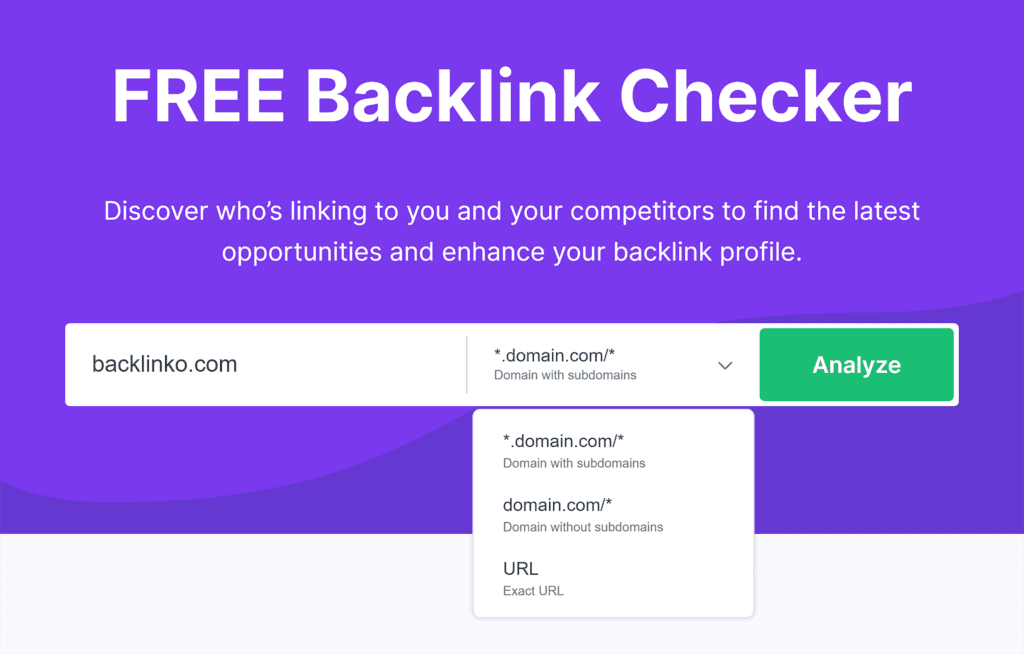How to Get High-Authority Backlinks from Relevant Websites In 2024
It’s comes under many names and guises – SkyScraper, Data-Driven content, Journalist outreach etc.
High Authority Backlinks: 7 Strategies That Help You Get Them
Ever seen those LinkedIn bios promising to “secure authority backlinks for better Google rankings”? SEO experts seem to swear by it.
But are high authority links really the key to SEO success? Should you invest time and effort into securing these high DA backlinks?
We asked top SEO experts to weigh in. Here’s what we discovered.
What Are High Domain Authority Backlinks?
A high DA backlink comes from a website with a high domain authority (DA) or domain rating (DR). DA is a metric developed by Moz, while DR is from Ahrefs. Typically, these scores are above 70-80.
When discussing high-authority backlinks, we mean links from websites that search engines trust. Think of sites like:
- Microsoft.com
- NYTimes.com
- Forbes.com
- Adobe.com
- BBC.co.uk
- SearchEngineJournal.com
- CNN.com
- HubSpot.com
- TechCrunch.com
These links signal to search engines that your website is a credible source. This can boost your content’s ranking significantly.
Moreover, a strong backlink profile can make your site more resilient to Google’s core algorithm updates. In other words, staying at the top gets easier once you’re big enough.
Moz Domain Authority vs. Ahrefs Domain Rating
If you’re deep into SEO, you’ve likely heard of Moz’s Domain Authority (DA) and Ahrefs’ Domain Rating (DR). These metrics are indispensable for figuring out how powerful a website is.
But what’s the real difference between the two?
Let’s break it down.
Domain Authority (DA)
Moz’s Domain Authority, or DA, is a score that predicts how well a website will rank on search engines. Think of it like a report card for your website, ranging from 0 to 100.
This score considers various factors, such as the number of links pointing to your site, the quality of those links, how long your domain has been around, and how big your site is overall. Higher scores mean stronger authority.
Domain Rating (DR)
Ahrefs’ Domain Rating, or DR, also scores from 0 to 100 but focuses specifically on the strength of a site’s backlink profile. This metric looks at both the number and quality of external backlinks.
Essentially, the more high-quality sites that link to you, the higher your DR will be.
Key differences between DA and DR
Although DA and DR are often used interchangeably, as you can see, they come from different companies and use different calculations.
Here’s a simple comparison:
- DA (Domain Authority): Moz’s metric looks at your entire site, considering factors like the number of links, their quality, the age of your domain, and the size of your site. It’s a holistic measure of your site’s overall authority.
- DR (Domain Rating): Ahrefs’ metric zooms in on your backlink profile, assessing the number and quality of backlinks, and the diversity of those links. It’s a more focused look at how strong your backlinks are.
Because they measure different things, a site can have a high DR but a lower DA, or vice versa.
Why use both DA and DR?
Using both metrics gives you a fuller picture of your site’s SEO health. According to our survey of 113 SEO experts, 69% of them trust Ahrefs’ DR as the go-to metric for domain authority, while 84.6% say relevance, site traffic, and domain authority scores are key for judging backlink quality.
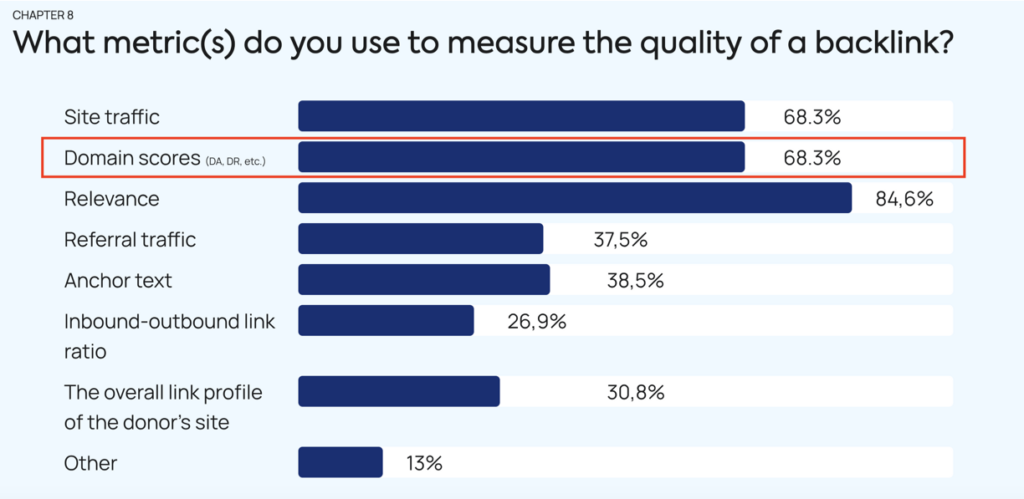
The Value of High Authority Backlinks
High authority backlinks (typically from sites with a DA/DR over 70) boost your rankings, increase your traffic, and build your credibility.
But these links don’t come cheap.
How to Get High Authority Backlinks
Here are some proven methods to snag those valuable backlinks:
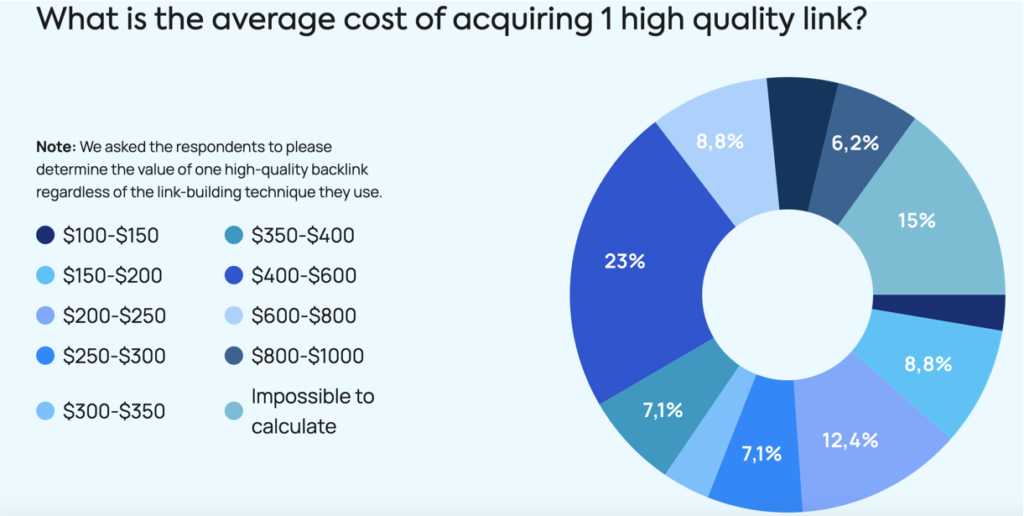
- Digital PR: This is the top choice for 67.3% of experts. It involves getting coverage in online publications to earn backlinks.
- Guest Posting: Writing articles for reputable sites is favored by 38.9% of experts.
- Connectively (ex HARO): Connecting with journalists seeking expert insights.
- PR Outreach: Promoting your best content to industry leaders and journalists.
- Link Swap: Partnering with reputable sites to exchange links, ensuring both parties benefit from increased authority and relevance.
- Broken Links: Scouring other websites for broken links and suggesting your relevant content as a valuable replacement, thereby earning a backlink.
- Link Bait Content: Creating exceptional, shareable content like detailed infographics, in-depth guides, or original research that naturally draws in backlinks due to its high value and engagement potential.
We’ll get into more details a bit later in this post.
For now, let’s just remember that high-authority backlinks are worth the effort because they lead to better search rankings, more organic traffic, enhanced brand credibility, and higher conversion rates.
Remember, one high-quality link can be more impactful than several lower-quality ones.
All in all, keep an eye on both DA and DR and focus on acquiring high authority backlinks. This way, you can create a solid SEO strategy that truly stands the test of time.
How ‘Authority’ Is Defined
In SEO terms, authority is all about how trustworthy, credible, and expert a website or web page is on a specific subject.
But how do we actually measure this?
Who Sets the Rules for SEO Authority?
Google and other search engines set the benchmarks for what counts as authority. They use a mix of factors to figure out where a page should rank.
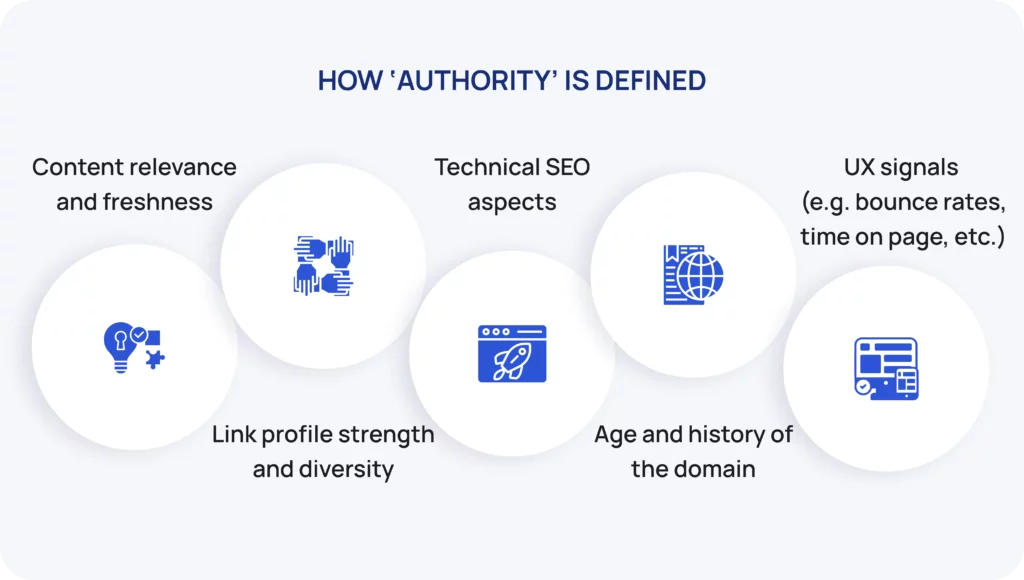
Here are some key elements:
- Content Relevance and Freshness: Is your content up-to-date and on-topic?
- Link Profile Strength and Diversity: Quality and variety of links pointing to your site.
- Technical SEO Aspects: Proper site structure, fast loading times, and mobile friendliness.
- Domain Age and History: Older sites often have more authority.
- User Experience (UX) Signals: Metrics like bounce rates and time spent on the page.
Surely, there are many other factors, but the ones above are the most influential. Collectively, they help Google determine the trustworthiness and authority of your site.
Are Backlinks a Trust Signal to Google?
Absolutely. Backlinks are a major trust signal for Google.
Think of them as votes of confidence from other sites. The more high-quality sites that link to your content, the more Google trusts your site.
This concept is part of E-E-A-T: Experience, Expertise, Authoritativeness, and Trustworthiness.
🔴 Here’s what Google says about it:
“After identifying relevant content, our systems aim to prioritize those that seem most helpful. To do this, they identify signals that can help determine which content demonstrates expertise, authoritativeness, and trustworthiness. For example, one of several factors we use to help determine this is understanding if other prominent websites link or refer to the content. This has often proven to be a good sign that the information is well trusted.”
So, backlinks act as third-party endorsements. If a reputable site links to your content, it tells Google your information is valuable and trustworthy.
The Role of DA and DR
While DA and DR aren’t used directly by Google, they provide valuable insights for SEO professionals.
Here’s how you can leverage these metrics to enhance your SEO strategy:
- Identifying High-Value Link Opportunities: Use DA and DR to identify which sites to target for backlinks. High DA/DR scores indicate a site’s potential to pass on significant authority to your site.
- Competitive Analysis: Compare your site’s DA and DR with competitors to gauge where you stand in the market. This can help you understand the competitive landscape and identify areas for improvement.
- Evaluating Link Quality: Before pursuing a backlink, check the DA or DR of the linking site. This helps ensure you’re investing efforts in links that will truly boost your authority.
- Tracking SEO Progress: Monitor changes in your DA and DR over time to see how your link-building efforts are paying off. An increasing score generally indicates successful SEO strategies.
- Budget Allocation: Use DA and DR metrics to prioritize link-building efforts and allocate your budget effectively. Focus on acquiring links from sites with higher scores for maximum impact.
- Partnership Decisions: When considering partnerships, guest posts, or PR outreach, DA and DR can help determine the potential SEO benefit. Opt for collaborations with sites that have strong authority metrics.
Nathan Gotch, Founder of Gotch SEO Academy, sums it up well:
Thus, as you can see, using DA and DR wisely can help you make informed decisions and optimize your link-building strategy.
At What Point Does a Website Achieve High Authority?
Determining exactly when a website achieves “high authority” is tricky. Many factors contribute to it, far more than just having a high DA or DR score.
Generally, 70+ DA or DR sites can be considered ‘trusted,’ but even that isn’t enough.

For instance, domain authority can be manipulated, so high DA or DR could be untruthful.
Nathan Gotch, Founder of Gotch SEO Academy, demonstrated this with an experiment of paying for backlinks to increase a site’s DR from 0 to 70; it showed that high DR doesn’t always mean genuine authority:
A high DR score doesn’t necessarily indicate genuine authority.
According to Steven J. Wilson, SEO Specialist and Consultant, to truly assess a site’s authority, you should consider these next three factors:
Emphasis on Relevance More Than Vanity Metrics
According to Jules Davies, E-Commerce SEO Expert and Founder at Scalerrs, while metrics like DA and DR are critical, they shouldn’t take away from the topical relevance of the linking site.
Links from related sites may signal to search engines that your content is valuable within the niche.
Relevance matters more than pure authority does.
For example, a link from a topically relevant site with a lower DR can be way more vital than a highly authoritative general site link that doesn’t share anything in common thematically.
Jules Davies emphasizes:
In my experiment, I searched “why submit 1099” (referring to a form used to report money paid to a non-employee for their services), which produced results that indeed demonstrate Google is using more signals than just a site’s DR number and count of backlinks to it.
Among high-DR results were law firms with less DR but with a lot fewer backlinks but relevant content.

This shows that Google values the relevance of content and expertise rather than just high authority scores.
The main takeaway here is to reach for backlinks coming from relevant and authoritative websites in the niche. This not only betters the site’s credibility, but it also aligns better with how search engines are now going about ranking quality links.
7 Strategies for Acquiring High Authority Backlinks
So how do you get high DA backlinks, you ask? After all, it’s one thing to identify them, but getting them is a whole different game.
Here are some proven strategies to secure those coveted high-authority backlinks.
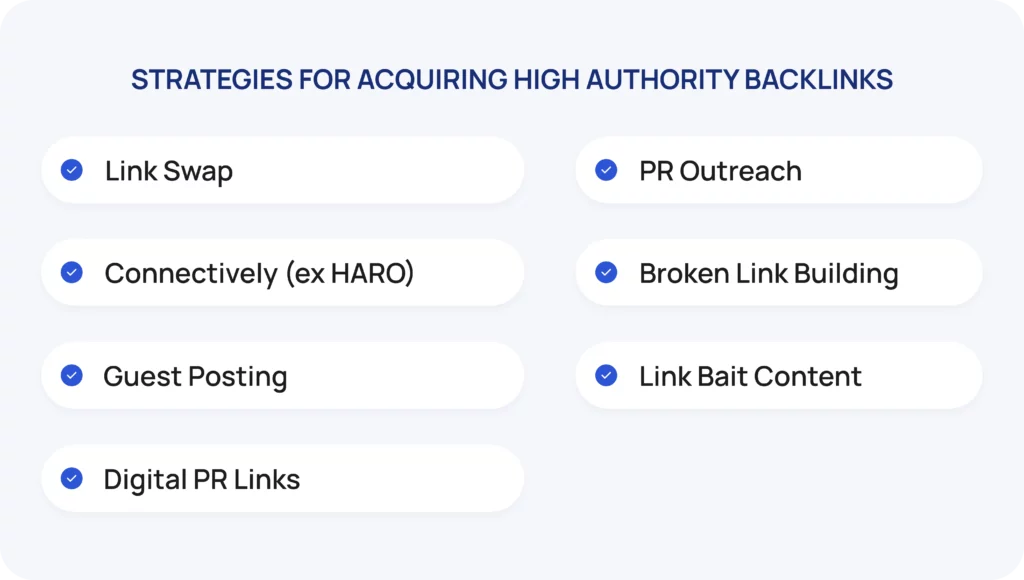
Link Swap
Link swapping involves link exchange with other websites. You reach out to a site you want a link from and offer a reciprocal backlink from your site.
Be cautious—Google frowns upon excessive link exchanges and may penalize your site for manipulative practices.
To avoid penalties, consider a triangular link exchange (ABC link exchange).
In this setup, Site A links to Site B, Site B links to Site C, and Site C links back to Site A. This method makes the link swap appear less direct and helps avoid penalties.
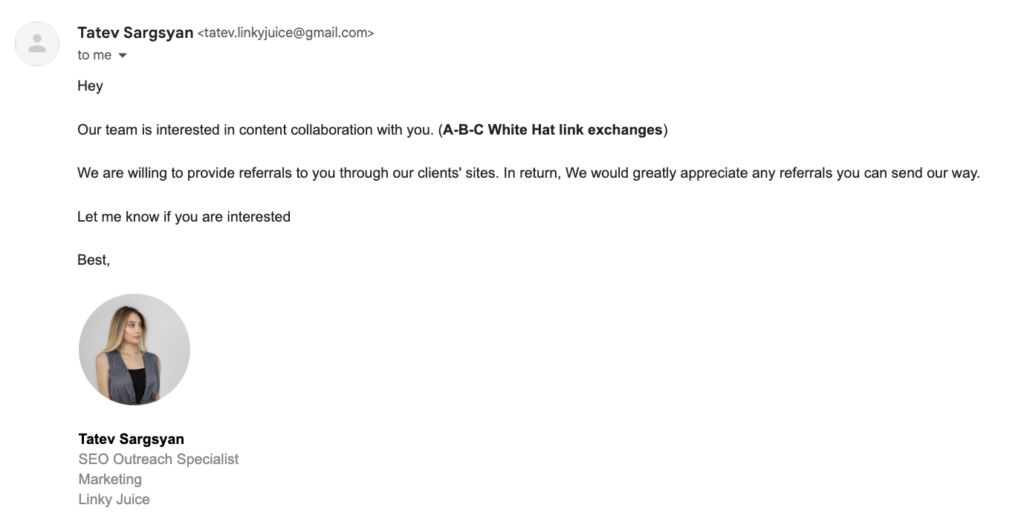
But remember, successful link swaps require decent domain authority. If your site has zero DR, high-DR sites like G2.com will likely ignore your requests.
✅ Editorial.Link will get you backlinks from reputable sites no matter your site’s DR or DA. We work with world-famous companies like podium.com, monday.com, namecheap.com, envato.com, cloudways.com, wordstream.com, and hubspot.com to ensure our clients receive only high-authority, contextually relevant links.
Connectively (ex HARO)
HARO, now part of Connectively, connects journalists with expert sources. Sign up and indicate the areas you are interested in to receive daily queries from journalists looking for expert insights.
Responding to these queries can land you backlinks from high-authority sites like Forbes, Business Insider, Zapier, and so on.

Here’s what a typical HARO request looks like:

- You never know which media outlet you’re submitting your quote to, as writers often prefer to remain anonymous. This anonymity makes it challenging to choose the right media opportunities.
- HARO’s conversion rate is unpredictable. You never know how many of your comments will get published, and it’s likely you won’t hear back from the journalist once the article goes live.
Guest Posting
Guest posting is a tried-and-true strategy for building high-authority backlinks.
Find relevant sites that accept guest posts and offer to write unique, high-quality content for them. Some sites have guidelines for guest authors, while others don’t—so don’t hesitate to reach out even if there’s no explicit invitation.

Guest posting allows you to include multiple backlinks in your content, which can also benefit your link exchange partners.
However, note that this tactic is quite resource-intensive, even more than link swaps or HARO link building, requiring time and effort to craft quality posts or funds to pay for writing services.
PR Outreach
PR backlinks come from mentions in media outlets. This involves reaching out to editors and pitching your link-worthy content.
PR link building can include link insertions, press releases, and thought leadership articles. Unlike guest posts or link swaps, PR backlinks often come with a narrative that enhances your brand’s visibility.
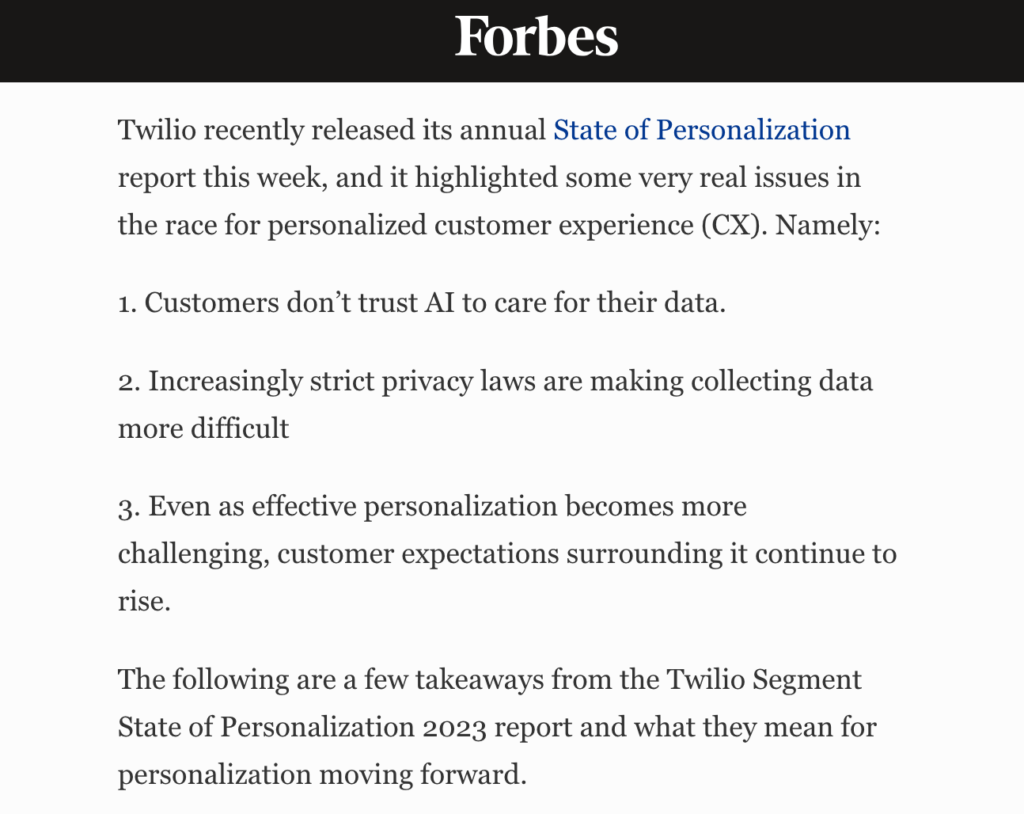
Broken Link Building
Want a smart way to score high-authority backlinks? Try broken link building. It’s all about spotting dead links on top-notch websites and suggesting your content as a replacement.
Yes, it can take some time, but the payoff is huge. After all, you’re helping site owners fix a problem, which boosts their user experience. In fact, recent data on Alnalytify shows broken link building often beats other strategies in success rate.
How do you get started?
Start by identifying your competitors’ broken pages with tools like Ahrefs, then reach out to the sites linking to those dead pages and offer your content instead:

- Use a website crawler or link analysis tool to sort the site’s pages by the number of inbound links.
- In Ahrefs, open Site Explorer, go to Pages -> Best by links, and filter for ‘Dofollow’ and ‘404 not found’ under HTTP Code.
- Once you identify sites linking to these dead pages, you can make a list for outreach.
Link Bait Content
Creating link-worthy content, or “link bait,” is a killer way to build backlinks. However, in 2024, you need to go beyond just good content.
Your stuff needs to be unique and highly relevant to stand out in the crowded content space.
Jakub Rudnik from ActiveCampaign notes that old tricks like stats roundups are played out. Instead, find a fresh angle and run with it.
And we can’t help but agree.
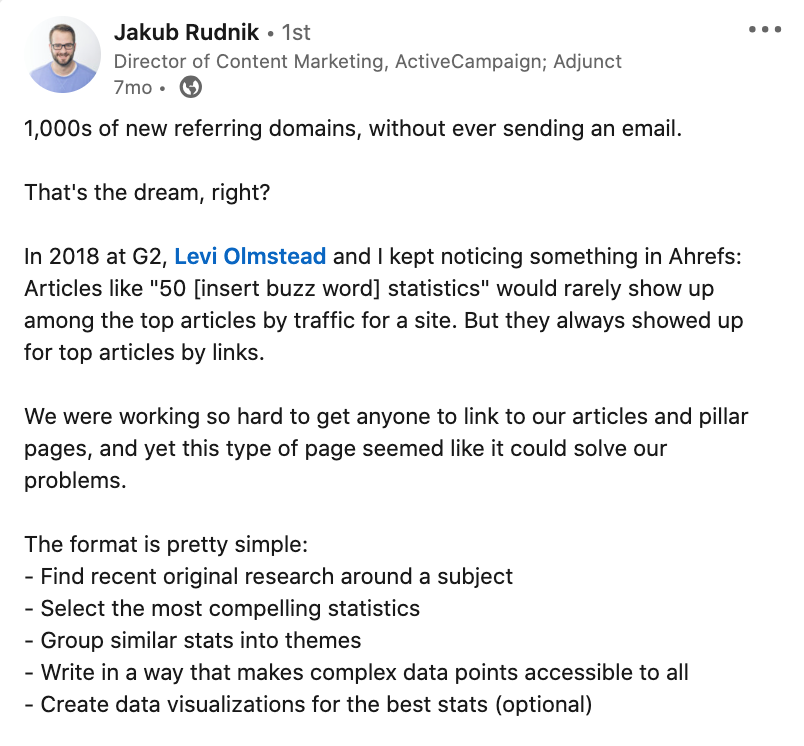
Sounds good, right? But here’s the second part:
“Sure, this strategy has been done to death over the past five years. At ActiveCampaign, we’re up against hundreds of ’email marketing statistics’ articles. With a DR of 90, we might crack page 1, but for most companies, it’s just not worth the effort.“
This means planning, researching, and crafting something almost no one else has. Plus, you’ll need strong PR outreach to spread the word and draw in those backlinks.
Digital PR Links
Digital PR is all about getting your brand noticed on the internet. When you’re featured in articles, news sites, and top-tier publications, it’s like giving your website a VIP pass to better SEO, a stellar reputation, and more visitors.
Picture this: you’ve launched a fashion brand, and your latest collection just went viral on social media. With Digital PR, fashion bloggers, influencers, and online magazines are buzzing about your trendsetting designs. You could even host a live-streamed fashion show!
Digital PR links come from trustworthy, high-authority sites, which means Google gives them a thumbs up, and that boosts your site’s credibility and SEO. Plus, they bring in visitors who are genuinely curious about what you offer.
Here’s an example:
Wrangler worked with AMP3 PR to launch an exclusive collection at Fred Segal Sunset, aiming to boost their modern business unit.

The campaign involved:
- Media and Influencer Outreach: Targeted high-end media outlets and fashion editors, organizing a celebrity and influencer event.
- Event Strategy: The “Elevated Fair” theme event attracted 300+ industry attendees and significant media coverage.
Results:
- 261 influencer mentions with a 93 million social reach.
- Google search volume for “Wrangler” in LA tripled.
- 30+ media hits from Daily Mail, ELLE, Variety.
- 972 million PR impressions valued at $89 million.
How do you secure digital PR links?
- Find the Perfect Outlets: Hunt down the media outlets and journalists who are into your industry. Make a hit list with big names and niche players.
- Create Irresistible Stories: Journalists love a good story. Use unique data, surveys, or intriguing angles to make your pitch pop.
- Personalize Your Pitches: Skip the generic emails. Use the journalist’s name, mention their previous work, and show why your story is perfect for their audience.
- Follow Up, Don’t Give Up: No response? No problem. Send a friendly reminder. Persistence works, but don’t be a pest.
Red Flags On Authority Backlinks
Not all high-authority backlinks are beneficial. So beware of relying solely on DA or DR metrics without deeper investigation.
Nathan Gotch, Founder of Gotch SEO Academy, warns against trusting surface-level metrics:
Evelina Milenova, SEO Manager at Opinion Stage, adds that if a website shows a high DR but has minimal organic traffic or an abrupt traffic drop, it likely wasn’t built with sustainable strategies.
Looking at DR/DA in isolation is highly misleading. If the website barely has any traffic or its traffic is not coming from the countries you’re targeting – it’s better to skip it. Another thing to look at is the traffic dynamic – you want to see stable growth rather than sharp fluctuations.
Here’s an example of what to avoid – the website has DR 72, but its organic traffic is just 1.1K. It’s clear that the DR has been manipulated (see the screenshot).

Another example is an abrupt traffic drop, which demonstrates the website wasn’t growing with sustainable strategies (see the screenshot).”
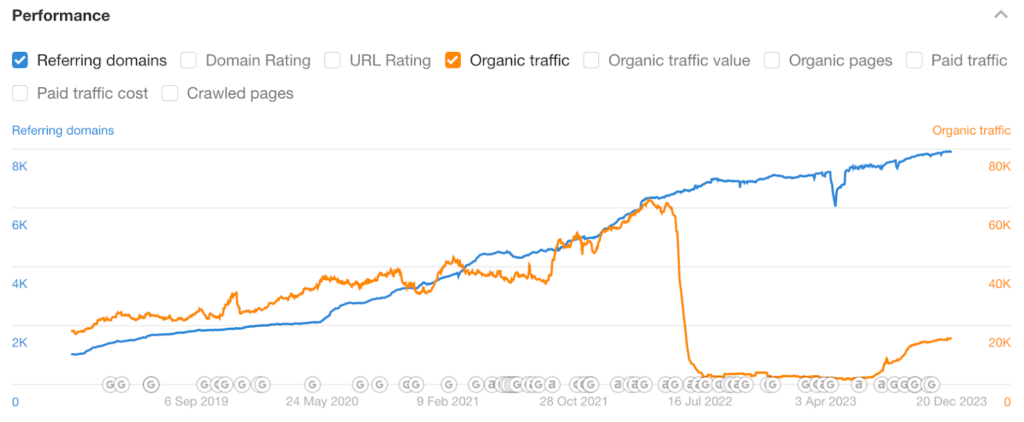
Evelina Milenova, SEO Manager at Opinion Stage
Remember, high-authority backlinks can supercharge your profile, but watch out for these red flags:
- Surface-Level Metrics: Don’t just rely on DR or organic traffic. Some shady vendors use expired domains and fake traffic to make links look good when they’re part of a Private Blog Network (PBN).
- Irrelevant Traffic: Make sure the site’s traffic comes from your target countries. A high DR site with minimal or irrelevant traffic isn’t worth it.
- Traffic Dynamics: Look for steady growth. Big spikes in traffic might mean unsustainable strategies or penalties.
Don’t Confuse Authority for Third-Party Metrics
Google uses authority as a trust signal, but DA and DR are third-party metrics that can be manipulated.
Always prioritize link relevance.
A relevant backlink from a site with a lower DA score can be more valuable than an irrelevant link from a high-DA site.
Securing high-authority backlinks requires a combination of strategies and careful evaluation. Prioritize quality and relevance over vanity metrics to build a robust and effective link profile.
How to Get High-Authority Backlinks from Relevant Websites In 2024

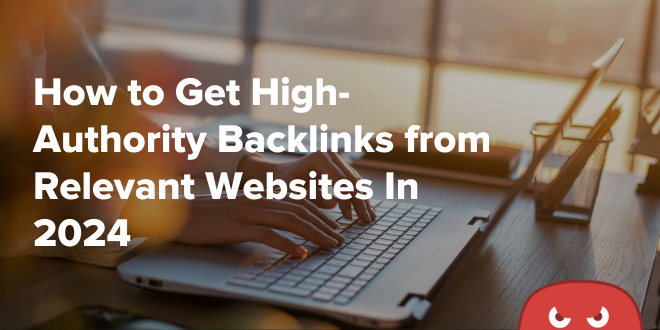
A backlink serves as a vote of confidence in your content from other websites, which signals to search engines that your content is valuable.
You won’t be able to climb the rankings and beat out competitors unless you have an authoritative backlink profile – especially in today’s ever-changing search landscape.
In fact, many SEO gurus assert that backlinks from high-authority sites are the #1 ranking factor that matters most, bar none.
What proof do they have that this is the case?
The #1 result on Google will have an average of 3.8x more high-authority backlinks than positions 2 – 10 , according to an in-depth study by Backlinko.
So if your SEO strategy doesn’t include going after high-quality backlinks, you’re missing out on higher rankings and more traffic.
Read on to discover the most effective ways to target and acquire backlinks from relevant and authoritative websites in your niche.
What Are High-Authority Backlinks?
Before we dive into high-authority backlinks, let’s make sure we’re all on the same page. If you’re new to SEO, the concept of backlinks might seem a bit unclear. Here’s a quick breakdown:
A backlink is simply a link from another website that ‘points back’ to yours . It’s created whenever you include a link to your website within content on another site.
This could be through guest posts, directory submissions, forum comments, or any place where you can add a link.
However, not all backlinks are of equal quality, and some aren’t worth pursuing at all.
Enter high-authority backlinks , which are links coming from relevant, authoritative websites that Google already trusts.
These types of backlinks will have the most positive impact on your SEO, which is why it’s worth putting time and resources into pursuing them.
Conversely, low-authority backlinks will have next-to-no impact on your rankings (neither negative nor positive).
Also, it’s crucial not to understate the importance of relevance here. In other words, your backlinks must come from websites that hold some type of relevance to your content.
Relevance can be:
- Direct . When a website has direct relevance to yours, it means they cover the same topics and cater to the same audience. More often than not, websites with direct relevance are your competitors, so it’s best to avoid this type of relevance whenever possible.
- Audience-adjacent . A link is considered relevant whenever it comes from a site that shares your target audience. An example would be a construction rental company linking to a construction blog. They aren’t competing for the same business, but they do share the same audience.
- Contextual . Some websites are only relevant to yours in context. For example, a news website wouldn’t be traditionally relevant to a construction company. Yet, if they’re running a story about construction rental businesses, the link is now contextually relevant.
It’s super important to ensure the high-authority links you target are also relevant. Otherwise, they won’t impact your rankings at all.
We’ll explore more about what makes a backlink authoritative (and how you can check for it) below.
Why are backlinks a thing anyway?
The concept of backlinks goes back to Google’s beginnings. When Larry Page and Sergey Brin were brainstorming ideas for Google, they drew inspiration from a familiar concept: academic citations.
Like research papers that gain credibility through quality citations, they envisioned websites earning authority through backlinks in a similar manner.
Think of it this way: Medical and scientific journals with numerous reputable citations carry more weight than those without. Google’s PageRank algorithm applies the same principle to websites.
If your website boasts backlinks from high-authority sources (think government institutions, universities, and trusted companies), your own content is seen as more authoritative and trustworthy .
It’s “guilt by association” with a positive twist – instead of guilt, you earn credibility!
Recognizing the power of backlinks ignited a quest among SEO experts to acquire these valuable links.
However, to target the right websites, they first need to understand a key question: What makes a website truly authoritative?
What’s Domain Authority?
Determining the level of authority a website has is crucial before pursuing a backlink.
Why is that?
It’s because there are high-quality and low-quality backlinks, and low-quality backlinks won’t have any impact on your rankings .
This means acquiring backlinks from sites that aren’t seen as authoritative or trustworthy is a waste of time, but how can you tell the difference?
Enter domain authority (DA) , a metric coined by Moz used to convey a website’s authority and trust level. Websites receive a score ranging from 1 – 100, with 1 being very poor and 100 being perfect.
While it’s not an officially recognized ranking factor by Google, Moz included many of Google’s known ranking factors into its equation.
Since official domain authority metrics from Google aren’t available (they stopped displaying PageRank data back in 2016), third-party approximations are the next best thing.
Besides Moz’s DA score, SEO software company Ahrefs has its Domain Rating , which is another score that rates the rankability (and overall trust level) of a website.
You can use our free domain authority checker tool to check the DA score for any website. Enter a URL, check the CAPTCHA, and hit the button to see a site’s DA score (even your own).
As a rule of thumb, you should check the DA score for every site you intend to pursue backlinks from to ensure they’ll positively impact your rankings.
Typically, sites with high domain authority are along the lines of industry thought leaders, enterprise-level companies, universities, nonprofits, and government agencies.
Here’s a quick breakdown of DA score levels:
- DA/DR scores ranging from 0 – 30 aren’t worth pursuing because they’ll have virtually no impact on your rankings.
- DA/DR scores ranging from 30 – 60 are fair game and worth conducting outreach to pursue.
- DA/DR scores ranging from 60 – 90 are highly authoritative and will have highly positive impacts on your rankings. This level of link-building often requires a partnership and editorial-strategy to achieve.
- DA/DR scores 90 and above are often legacy websites that may be unattainable or too expensive (think websites like CNBC).
A high domain authority isn’t everything
While backlinks with high domain authority scores are certainly valuable, you shouldn’t let high DA scores blind you. Here’s why:
Relevance is king
Imagine you have a website about vegan baking. A backlink from a high-authority sports website might seem impressive, but for your target audience, it carries little weight. Search engines prioritize relevance above all else, and they’ve become extremely adept at identifying it.
In fact, Google will simply ignore irrelevant links, despite how authoritative they may be.
Here’s the cold, hard truth: A backlink from a niche baking blog with a moderate DA will have more of an impact on your SEO than the high-authority sports link.
That’s why you shouldn’t place your emphasis entirely on high DA scores. Instead, ensure each high DA link you pursue also has some form of relevance (see the types of relevance above).
Don’t underestimate niche websites
Don’t discount the potential of new websites with lower DAs.
If a new site is producing high-quality content within your niche, it has the potential to become a major player in the future.
Building relationships with these up-and-comers early on can pay dividends when their authority grows. If they’re actively investing in SEO ( 69% of companies do), then they’ll likely become authoritative sooner rather than later.
When it comes to looking for high authority links, there are two things to keep in mind:
✅Focus on quality over quantity: It’s usually better to have a few high-quality, relevant backlinks than a large number of irrelevant ones. Prioritize links from websites that complement your content and resonate with your target audience.
✅Building long-term relationships: By focusing on building genuine relationships with website owners in your niche, you can secure valuable backlinks now and cultivate partnerships that benefit you both in the long run. Building partnerships and editorial strategies will help you snag backlinks with DA scores in the 70s and 80s.
ℹ️ The takeaway : A well-rounded backlink profile should include a mix of high-authority and niche-relevant links. Prioritize quality and relevance over pure DA scores, and keep an eye out for promising new websites within your field.
The 16 Types of Backlinks
Link-building has evolved substantially since its beginnings in the late 90s, as there are now 16 distinct types of backlinks that SEOs target.
However, some types of links are superior to others. For instance, editorial links on relevant, authoritative websites will do more for your SEO than getting listed in a general business directory.
Here’s a look at all 16 types of backlinks in descending order of value (i.e., the most effective backlink types are at the top of the list).

#1: Editorial backlinks
An editorial backlink is when a high-authority website links to one of your content pieces to support its own work.
An example would be a website linking or embedding an infographic you created that has helpful statistics or industry information. Other ways you can obtain editorial backlinks include:
- Another website cites your content as a source for one of their posts
- Someone vouches for the quality of your website and provides a link
- A website chooses to include your website in a link roundup
- Someone interviews an employee from your website and includes a link
The best way to acquire these links is to create high-quality, data-driven content that’s valuable to your target audience.
If you do that, other websites will start to notice and link to your web pages, essentially letting your content sell itself. That’ll make outreach a breeze; if the post is relevant enough, you won’t have to work too hard to promote it.
In fact, some of the backlinks you’ll acquire won’t involve any outreach at all. Bloggers and content creators are always on the hunt for relevant statistics, videos, and infographics to use on their websites. So, if you provide the goods, you’ll generate backlinks without having to send a single email (although following up with outreach to build a relationship is always a good idea – see below).
#2: Relationship-based backlinks
This type of backlink blossoms out of a relationship with another website, journalist, or content creator.
Once they begin to link to your content more than once, it’s considered a relationship-based backlink.
These are extremely valuable because they aren’t a one-off thing. If another content creator views you as an authoritative thought leader in your field, they’ll likely link to your content more than once, maybe even dozens of times – which is great news for your backlink profile.
How can you establish these types of relationships?
You can by paying close attention to the editorial backlinks that you pick up. Whenever you notice that another website has linked to one of your pages, do some outreach via email or social media.
Formally introduce yourself, and thank them for linking back to your website. From there, you can provide some additional links to your high-quality content for further reading.
Not only that, but you should praise their blog content and offer to include a backlink on your website to their content, which is an excellent way to kickstart a mutually beneficial relationship where you both link to each other’s pages.
If you keep this up, you’ll build a bustling network of link partners who will consistently supply you with valuable backlinks.
#3: Guest blogging backlinks
Another age-old tactic for acquiring backlinks is to write guest posts on other websites in exchange for a backlink.
While guest blogging can be a reliable way to generate high-authority backlinks, you must know how to do it properly.
Otherwise, Google could think you’re trying to game the system with spammy links.
Most importantly, your guest posts must be relevant to your website and provide valuable content for the website you’re posting on .
Why is that?
It has to do with Google’s rigorous quality standards for its search rankings. Google only wants to display the highest quality, most relevant results for search queries.
If the top results suddenly become irrelevant, spam-heavy articles without any valuable information, Google will lose business, as searchers will go elsewhere.
That’s why your guest posts must be of the utmost quality and relevancy for your target audience if you want to rise through the rankings.
To find the most success, only establish guest post relationships with other high-quality, trustworthy websites in your niche (be sure to check their DA score with our free tool first). As long as you do that, your guest post relationships will yield many high-authority backlinks.
#4 HARO backlinks
HARO (Help-a-Reporter-Out) is a platform that connects journalists in need of expert sources with relevant industry professionals online.
In other words, it’s basically a backlink-generating machine.
It works like this: several emails go out each day containing hundreds of journalist queries organized by industry (i.e., business and finance, high tech, education, etc.). Industry professionals can then browse these queries and respond to them.
More often than not, journalists are after quotes from industry experts that they can use in their stories.
If they choose your response, they’ll provide a link back to your website alongside your quote/resource. HARO is so valuable because it can lead to high-authority backlinks from major news outlets and reputable websites in your niche.
That’s not to say that generating backlinks through HARO is a breeze, as there are fierce levels of competition. It’s likely for each query to receive dozens or even hundreds of replies, so your pitch needs to stand out.
How HARO works (step-by-step)
Here’s how you can get started as an industry professional on HARO:
- Sign up: Create a free HARO account and select the categories relevant to your expertise.
- Receive HARO emails: You’ll get three emails daily (morning, afternoon, and evening) containing queries from journalists across various fields.
- Scan for relevant queries: Comb through the emails to find opportunities where you can provide valuable insights.
- Craft a compelling pitch: Respond with a concise, well-written pitch that demonstrates your expertise and directly addresses the journalist’s query.
- Follow guidelines and deadlines: Adhere to the journalist’s specific instructions and submit your pitch promptly. Journalists will quickly ignore responses that don’t follow their guidelines (or are irrelevant), so double and triple-check the instructions and deadline.
ℹ️Tips for HARO success:
- Speed: Respond to relevant queries quickly to increase your chances of selection. As stated before, it’s normal for journalists to receive hundreds of replies, and the early bird tends to get the worm.
- Quality: Put effort into your pitches. Proofread carefully and tailor your response precisely to the query. Also, try to think of ways that you can make your pitch unique from others. Do you have unique first-hand experiences to share or insights that other professionals don’t know about?
- Follow-up etiquette: A polite follow-up is acceptable, but avoid being pushy.
#5: Backlinks from free tools
There’s an SEO-specific reason why we have so many free tools that anyone can use on the HOTH website.
Besides wanting to help as many people as we can, free tools are a fantastic way to acquire high-authority backlinks naturally.
For instance, how many website owners need to conduct keyword research and check competitor backlink profiles each day?
The answer is in the thousands.
For example, many website owners flock to our free SEO tools (the keyword planner tool and backlink tool in particular) to meet their needs. Beyond that, they also share our tools on their websites, blog posts, and social media profiles, generating loads of backlinks .
For instance, Hubspot included a link to our local SEO tool in one of their blogs , which you can see here:

Our free tools help us snag high-authority backlinks like this all the time, which is why we love them so.
You can also incorporate this strategy on your website by providing free tools or another valuable free resource.
To come up with a helpful tool, do some research on your audience to uncover their problems and pain points. After that, see if you can come up with a tool (or scale down a paid tool) that solves those problems.
Next, do some outreach to high-authority websites in your field to see if they’ll link to the tool in their content (or review it).
#6: Press release backlinks
Press releases are a classic public relations tactic and happen to work wonders for acquiring backlinks.
If you’re rolling out a press release containing big news from your company, journalists in your niche may create posts about it and link to it.
Even better, high-authority media outlets can report on and link to your press release, which are the cream of the crop (they’ll have a highly positive impact on your search rankings).
Here are a few news topics that are worthy of creating a press release for:
- Launching a new product line or service
- Opening a new location
- Making a charitable donation
- Presenting an award you recently received
- Highlighting achievements from your team
- Announcing a new partnership or sponsorship with another company
- Rebranding your business with a new name or logo
These are all subjects that are bound to generate a buzz online, so don’t hesitate to create product releases about them.
However, there’s one topic you should avoid – and that’s time-sensitive events. If your goal is to generate traffic and backlinks from a press release, then you shouldn’t mention an upcoming promotion or event.
Why is that?
It’s because as soon as the event or promotion happens, your press release is no longer relevant, and you’ll have to take it down.
Stick with ‘evergreen’ press release topics that don’t have expiration dates. That way, they’ll continue to generate traffic and provide link juice to your content.
#7: General website directories
There are plenty of website directories out there, and getting listed on them will score a backlink for you.
In fact, backlinks from general directories are among the easiest to get. For the most part, they accept links from any type of website, regardless of the topic, industry, or even its quality.
How valuable are they?
Outside of the major players (see below), Google doesn’t contribute much ranking power to most general directories online. Once again, it has to do with Google’s obsession with quality and relevance, which these directories largely ignore.
That doesn’t mean you should entirely ignore general directories; it’s quite the opposite. It’s just that you shouldn’t go hog wild getting your website listed on every general directory online, as that won’t amount to much.
Instead, focus only on the largest, most trusted website directories, such as Yelp , Yellowpages , and Local.com , as Google does value their links.
#8: Niche website directories
Instead of getting listed on tons of general directories, you’ll find more success focusing on a handful of niche directories.
What are those?
A niche directory contains business listings for specific industries and topics.
They tend to be more selective and more challenging to get listed on than general directories and have a specific focus. For instance, if you sell fitness equipment, you could search for niche directories that list fitness equipment providers.
An example would be G2 , a niche directory for software companies.
Google values niche directories far more than general directories for two reasons.
First, they have a clear focus and target audience instead of being geared toward everyone/everything. Next, they don’t accept anyone who applies. Instead, they have higher quality standards than general directories, which is what Google wants.
While it may be harder to find niche directories, getting listed on them will positively affect your SEO profile.
Also, as long as the directory is relevant to your niche, you don’t have to stop at just one link to your website. If you have the content for it, you can get more pages from your website listed in the directory, which will help your SEO efforts even more.
#9: Paid Links
While you can pay companies, websites, and publishers for backlinks, it’s not always a good idea.
Google views paid backlinks as a ‘black hat SEO’ tactic that aims to trick the algorithm into ranking content higher that didn’t legitimately deserve it. Paid links pose a risk as a result, as using them can lead to Google penalizing your site.
Does that mean you should NEVER pay for backlinks?
It actually doesn’t, as there are ways to pay for backlinks while avoiding scrutiny from Google. In a nutshell, the way to do it is to make the links look as natural as possible.
That means if you do pay for links, you need to make sure that the links are from high-quality, relevant websites. Moreover, ensure the content you’re getting links for is some of your absolute best work.
If you pay for guest posts and follow the two rules above, your paid links will likely pass as quality links – remember to make them appear as natural as possible.
Despite all the risks because of Google’s staunch stand against paid links, paying for backlinks is a practice that’s still very much alive, and it’s not only dastardly black hat SEOs that are doing it.
How to make paid links work
Some white-hat SEO gurus still pay for links; they just know how to make them appear natural.
The risk is akin to speeding on the highway. Sure, you could get pulled over for a ticket, but there’s no denying that driving faster will get you to your destination quicker.
In the same vein, paid links can increase your search engine rankings; otherwise, nobody would still do it.
Pro tip: You never want to pay a website owner directly for a backlink (i.e., offering $500 in exchange or a link pointing to your site), as that’s a blatant link scheme and a surefire way to get caught. Instead, there are ways to buy high-authority links without directly violating Google’s policies.
A popular method is to outsource your link-building strategy to a trusted agency that can earn you desirable backlinks.
While you’re technically paying for backlinks, using this method is not against Google’s rules .
That’s because you’re paying someone to create resources, perform outreach, and build relationships on your behalf, which isn’t a link scheme.
There are some links that you can buy directly without getting in trouble, but they’re nofollow links.
What are those?
A nofollow link will only have a marginal impact on your search rankings, as it’s a signal to Google’s algorithm not to consider the link . While SEOs used to think that nofollow links passed no link juice whatsoever, that’s not entirely true.
Nofollow links still pass a tiny amount of link juice to your site, and they can still generate traffic for you – regardless of the nofollow tag.
Conversely, dofollow links do affect search engine rankings, which are the types of backlinks you want to target the most.
For this reason, you should do your best to ensure every link you acquire is a dofollow backlink; otherwise, you won’t gain as much visibility on search engines.

#10: Business profile links
Another type of backlink is a business profile link, which exists on social media platforms (Facebook, LinkedIn, etc.), industry directories, and local citation profiles.
These types of backlinks are especially important for local SEO strategies, as these business profiles are where consumers go to discover local products and services.
The theory here is simple, as you create accounts for your business on different platforms, look where you can include a backlink to your website. Yelp, Facebook, LinkedIn, and YellowPages are all examples of platforms that allow you to link back to your site, so don’t forget to create an account for your business on each one.
Business profile links are among the easiest to acquire, so make sure someone at your company is in charge of including a backlink whenever you create a new profile on a platform or directory.
Another type of backlink is a business profile link, which exists on social media platforms (Facebook, LinkedIn, etc.), industry directories, and local citation profiles.
These types of backlinks are especially important for local SEO strategies, as these business profiles are where consumers go to discover local products and services.
The theory here is simple, as you create accounts for your business on different platforms, look where you can include a backlink to your website. Yelp, Facebook, LinkedIn, and YellowPages are all examples of platforms that allow you to link back to your site, so don’t forget to create an account for your business on each one.
Business profile links are among the easiest to acquire, so make sure someone at your company is in charge of including a backlink whenever you create a new profile on a platform or directory.
#11: Webinar links
It’s a fact that a link will get more clicks when it provides a valuable resource for your audience.
The principle is the same as a squeeze page for generating email leads – you provide a freebie in exchange for something valuable. In the case of a squeeze page, it’s a customer’s email address.
In our case, the prize we’re after is a backlink that generates a lot of organic traffic.
How do you do that?
You can by providing a link to a webinar (or podcasts) with valuable insights, techniques, and information for your audience.
In the case of webinars, you’ll gain more value from the links if you record them and archive them on your own website so viewers can always access them..
A recorded webinar is a powerful tool you can use to not only score backlinks but also generate a ton of organic traffic. That’s especially true if your webinar contains valuable information your audience can use to better their lives.
Podcasting is another way to get backlinks.
If your podcast has a high-profile guest or contains something unique (such as proven-effective digital marketing techniques), the chances are high that other content creators will link to your episodes, generating backlinks for you in a very natural way.
You can also use your podcasts and webinars for future guest post outreach opportunities, so make sure to hold onto them in your archives.
#12: Sponsorship links
Another option is to mimic sports athletes and go for sponsorships. Yet, rather than trying to score your photo on the Wheaties box, you’ll want to form sponsorships with high-authority websites in your field.
Sponsorship links offer a way to secure placement on reputable sites, boosting your SEO in the process.
These are backlinks you acquire from another website in exchange for some form of compensation. This compensation could be:
- Money (direct sponsorship)
- Free products or services
- Reciprocal links (if you link to them as well)
- Other forms of promotion or benefits
How sponsorship links work
Usually, you would reach out to websites within your niche that have high domain authority (DA) and propose a sponsorship arrangement in exchange for a backlink.
From there, your backlink will be featured on a dedicated “Partners” or “Sponsors” page. This signals to search engines that you have a legitimate association with the website.
Sponsorship links can be a valuable tool, but they come at a cost. You’ll need to weigh the potential SEO benefits against the financial investment or other resources involved in the sponsorship arrangement.
#13: Award badge backlinks
Here’s a type of backlink that most SEOs overlook: the branded award badge .
Create an award or special ranking for other websites in your field. It’s important not to skimp here; make it a legitimate award worth winning – complete with a sleek branded badge they can place on their website (which is actually a backlink to your site).
It’s crucial to note that it can take some time to establish your badge as something valuable and sought-after in your field, so this is a bit of a long-term strategy.
Once you do, however, websites in your niche will start to line up to receive your awards, which will translate into high-authority backlinks for you.
How it works
- Design a legit-looking award : Focus on a specific aspect of your field (e.g., “Best Sustainable Fashion Brands,” “Top Pet Blogs of the Year”). Ensure your selection criteria are clear and based on merit.
- Create an eye-catching badge : The badge itself should be visually appealing and serve as a symbol of achievement. The cooler it looks, the more other websites will want to include it.
- Promote your award : Spread the word to related websites and encourage them to participate.
Why it’s a smart strategy
✔️ Websites crave recognition: Awards provide social proof and credibility for other businesses, making your badge desirable.
✔️ Viral potential: If your award gains respect, sites will share their win, spreading awareness of your badge, backlink, and brand.
#14: Backlinks from comments
Many websites, such as Forbes , Medium , and user forums like Reddit , allow you to include links in your comments.
You should be able to guess where this is going.
By commenting on these websites, you can include links pointing back to your content, which can help you accumulate backlinks.
Yet, this is a strategy you should use in moderation.
If you comment and link back to your site on every website you find, Google will likely flag them as spam.
Not only that, but the last thing you want to do is include a backlink on a low-authority website. Instead, stick to websites that have a high DA score and already rank high on search engines, like Forbes and Medium. You should also target websites that are within your niche.

#15: Backlinks from forums
Forums offer a chance to earn backlinks while engaging with your target audience. However, proceed with caution – as overt self-promotion will backfire.
❌ The wrong approach
Avoid blatant advertising like “CLICK HERE to check out our amazing products and services now!”. Users will ignore this, and it could displease search engines.
✅ The right approach
- Be relevant: Seek out forums where your expertise aligns with ongoing discussions.
- Be helpful: Offer genuine insights and solutions to users’ problems.
- Introduce links organically: When it adds value to the conversation, you might say something like: “Hey [forum poster], I noticed you’re struggling with writing compelling blog CTAs. We recently wrote a comprehensive guide on this; maybe it’ll help!”
Why this works
Prioritizing valuable contributions to the community means your backlinks become natural extensions of the conversation. This establishes your expertise and increases the likelihood of people clicking through to your website.
#16: Footer, header, and sidebar links
Lastly, you should know that where your link shows up on a page affects its value.
In particular, Google does NOT consider links that show up in the header, footer, and sidebar of a page valuable.
Why is that?
It’s because these are ‘sitewide links’ that appear on every website page.
Google’s algorithm has learned to assess the relevance and value of a link based on where it appears on the page.
Which spot on the page has the most value?
Links embedded in the middle of the body content of a page will always carry the most value. Backlinks in this area serve a purpose for readers and have a use and a context (supporting the blog content with additional relevant information).
If one of your backlinks appears in the header, footer, or sidebar of a page, Google will largely ignore them , as it views them in the same context as navigational links (Home, About Us, etc.).
So whenever you do outreach to acquire backlinks, ensure that your clients place them in the body of their articles and not in the header, footer, or sidebar.
Backlink Building Strategies
Now that you know more about the 15 types of backlinks, let’s learn some proven techniques for acquiring them.
Replacing broken links
A great way to acquire links and provide public service for the internet is to replace broken links online with your content.
Link rot is a real thing, and there are thousands of broken links online as a result.
To find them, you can use Ahrefs Broken backlinks tool. The goal is to find broken links for content that you can easily replace. For instance, if you find a broken link for a blog on a topic you’ve already written about, you can simply replace it with your existing blog.
Here’s how it works.
First, log in to your Ahrefs account and select the Site Explorer tool. From there, enter the URL of a website you want to check for broken backlinks.

Ahrefs will direct you to the website’s Overview , but we want to select Broken backlinks under the Backlink profile section.

You’ll need to contact the website owner to replace the link. Explain that you found a broken link but have an adequate replacement. As long as there are no conflicting interests, they’ll likely agree to it.
The skyscraper technique
A fantastic link-building strategy involves outdoing competitor content to poach their high-authority backlinks.

It works like this:
- First, check Google search for top-ranking pieces of content in your niche that have desirable backlinks (you can use our backlink checker tool to check out their link profile).
- Brainstorm ways to create a similar piece of content that’s 10x better. (i.e., go into more detail, provide new insights, and include a video or an infographic)
- Publish your content and reach out to the original post’s backlinks.
- Link to your piece and let them know you’d like them to link to your content instead. If it is 10x better than the original, they’re more likely to link to your content instead.
This is a highly effective technique that you can use to penetrate the top results on the SERPs (search engine results pages).
According to a case study by Hubspot , they were able to use the skyscraper technique to drive over 70k page views.
Creating infographics
Infographics are one of the most effective types of content you can create to acquire backlinks.
They’re great because they convey complex information in a visual manner – making it far easier to understand. In fact, posts with images contain a 650% higher engagement rate .
An infographic can contain eye-opening statistics, crucial facts, and other relevant information.
Moreover, bloggers love linking to infographics because they convey information effectively. As such, if you create a detailed, visually pleasing infographic containing relevant facts, many other bloggers will link to it – generating natural backlinks for you.
Final Takeaways: High-Authority Backlinks
If dominating search results is your goal, high-authority backlinks are essential. They signal to search engines that your content is trusted and valuable. Since Google’s earliest days, links have been the backbone of its ranking algorithm.
Building a strong backlink profile takes focus and effort, but the rewards are undeniable: higher rankings, increased visibility, and greater authority in your niche.
Ready to Take Action?
If you haven’t yet developed a comprehensive link-building strategy, now is the time! Check out our elite-level link-building services at The HOTH today.
Recommended tools FREE
- SEO Report Tool
- SEO Audit
- Conversion Rate Calculator
Landing High Authority Backlinks in 2024
Everybody wants links from high authority websites. This article will go into depth on the reasons why high authority backlinks are important for SEO, and challenge the status quo on how to earn those links.
What is a High Authority Backlink?
A high authority backlink is a link from any website which has a high domain authority (DA) or high domain rating (DR) score of above 70.
Sites that have a DA or DR score above 70 typically have a huge volume of good links pointing to them, and they’ve been around for a very long time.
You want to earn as many high authority backlinks as you can, because they’re going to increase your site’s domain authority and help you rank higher in search engines.

Let’s Explain the Concept of ‘Authority’
When people in SEO talk about a site having ‘authority’, they’re really referring to whether it has a strong reputation as a thought leader in any given industry.
SEO software company Moz created a ranking system called ‘domain authority’, which ranks a website on a scale between 1-100. The higher ranking, the better your domain authority.
For example, Facebook and Amazon have an incredibly high DA score of 96.

Nowadays, the DA ranking system is seen as outdated by many SEOs, who prefer to use the Ahrefs DR (domain rating) system. Again, it’s based on a score between 1-100, but is considered more accurate than Moz domain authority.
If you’re looking to improve your DA score, check out this article we wrote – How to increase domain authority.
How Google Judges Link Quality

It’s important to understand that not all backlinks are equal.
🚀 Want High Authority Backlinks on Autopilot?
📞 Book a call 📞 Book a call

Links are a trust signal to Google
Google places more trust on links that come from established websites that have a strong, trustworthy reputation.
This makes perfect sense when you think about it, because Google needs a system to give weighting to links, they can’t treat all inbound links as equal.
If you have a link coming from an editorial article on Vice or Business Insider, that’s going to be considerably more influential than a link from your local barber’s website.
👉 Discover our link building services, where we build these influential links at scale for Global clients.
If only link building were this easy.


If you have lots of links from high authority sources, Google is going to inevitably rank your website higher, because the algorithm is being told “This site is trusted be all of these fantastic sources, we should really give them more visibility in our search results, because this is a good website”
How important is DA?
Generally speaking, a higher domain authority or domain rating correlates with better ranking positions in Google.
Having a higher DA score does definitely correspond to generally higher rankings, provided you also have a strong on-page SEO and content strategy.


With that said, there’s always outliers in SEO, and although the average top ranking pages are going to be from sites with a higher DA score, there’s still plenty of successful websites with a lower DA score, as shown below.


Google is also looking for relevance, which is why it’s important to have lots of links from websites related to your particular industry.
Lastly, there’s a misconception that low authority links are somehow ineffective, or even bad, but that couldn’t be further from the truth. Provided the website is a credible source and not a spammy, blackhat type of link, then you’re going to be pushing your site in a positive direction with each new inbound link.
What are High Authority Backlinks Exactly?
High authority backlinks can be defined as links from highly trusted sources.
When is a website considered high authority?
In terms of metrics, any website with a domain authority (DA) of greater than 70 can be considered a high authority website.
However, in some industries the benchmark for a high authority site can be much lower.
For example, a website in the pet industry with a domain authority >55 would often be considered high authority, because there’s a much smaller pool of sites in that space compared to an industry like business or marketing.
Therefore, the average authority of sites in that industry is going to be significantly lower.
Additionally, there are a ton of DA75 websites which are absolute junk. So just because a website has a high DA score, doesn’t mean it’s good.
Quality over Quantity
Many people in the SEO industry are obsessed with link volume, mainly because studies show that more links equals higher rankings.
For example, we looked at websites in the CRM space, and found that generally speaking, a larger volume of inbound links equates to more search traffic per month.


So we should all just focus on building link volume right?
The main reason being, is that we end up going after a higher volume of mid-range links, and don’t reap the incredible rewards that high authority links can provide.
Us SEOs use tools like Ahrefs to figure out the link gap between different pages, and assume that achieving the link gap will lead to success.
Link quantity is important, but I often find that getting caught up on quantity clouds your judgement when it comes to quality.
So yes, use a link gap strategy to cherry pick the best links that your competitors have, but don’t get overly obsessed with link volume alone.
I’d estimate that a single link from a super high authority site >DA 75 is worth more than 5-10 links from a lower authority website (DA 30)
How To Land High Authority Links
Landing real high authority links is incredibly difficult, which is why legitimate link building agencies will charge high fees for the service.


With that said, we’ve outlined some of our most popular methods of getting backlinks below.
Guest Posting
I don’t care what anyone says, this is still the most reliable way to get the most incredible backlinks from incredible websites.
However, when I talk about guest posting for high authority links, I mean an incredibly high quality of content.
For example, a couple of years back we a legitimate guest post on HubSpot (DA 92 website) for our client in the real estate space.
We pitched them some genuinely amazing ideas, and explained what the article would be about. We also used our client’s own persona for outreach, so we had a lot of social proof and credibility behind us.
The HubSpot team were supremely well organized and understood the value proposition.


I consider this a fair trade – HubSpot received 100% free content from us, and one of our best writers spent over 10 hours carefully crafting the content, researching sources and putting together images.
That guest post now has over 80 sites linking to it, and it ranks #1 on Google for ‘real estate business’ and ‘starting a real estate business’


To be honest, landing this guest post would easily be worth $10,000.
You just can’t actively achieve these links any other way unless you get lucky and a writer decides to cite your source without your knowing.
Why people fail at guest posts…
Where 99% of people guest posting fail is in their approach. They use sloppy outreach and they create generic listicle style content.
🚀 Want High Authority Backlinks on Autopilot?
📞 Book a call 📞 Book a call



We come up with amazing content ideas using keyword analysis, and our content is created by amazing writers. We create a no-brainer proposition for websites, by completing the whole content creation process for them to an insanely high standard.
Of course, in many instances the website is going to respond to you asking for money. If that happens, you’ll need to consider whether buying backlinks is the right option for you.
HARO
HARO (help a reporter out) is a platform that connects journalists with sources.
Writers from big publications like GQ, Business Insider and Vice are active on the HARO platform.
The process is very simple – Journalists tell people what insights they’re looking for, and you email them your insights.
If you’re successful, the journalist will mention your comment in their article, and they’ll link to your website.
It’s a great, scalable way to build lots of good links to your homepage.
For the secrets behind successful HARO campaigns, check out this guide.
Link Exchanges & Swaps
This is a very underrated strategy, and if done correctly it can be incredibly safe.


The idea is very simple – Most established sites will have an SEO team, who understand the value of links. They already understand the value proposition of earning them a link.
Why link exchanges work…
Internal SEO teams and marketing teams understand the value of link building, and generally they’re happy to link out to you provided your website is genuinely relevant and equally as good as theirs. Of course, on the condition that you earn them a link in return.
You can either link to them from your own website, or get them a link from another website – perhaps a site that you’re planning a guest post on.
It’s a simple transaction that works. Of course, you do need to be smart about it and get creative, because engaging in overt link swap schemes is against Google’s rules.
We’ve talked about link exchange strategy in more detail here, so use this guide if you want to do it in an effective manner.
PR Outreach of Linkable Assets
This is the strategy that everybody idolizes, but is exceptionally difficult in practice.
It’s comes under many names and guises – SkyScraper, Data-Driven content, Journalist outreach etc.
But it basically amounts to the same thing – Create an incredible piece of content and show it to the right people. We’ve developed a methodology to consistently land PR backlinks, but it’s tough.
If you want to learn how to succeed, I’d recommend enrolling in Brian Dean’s new course – Get Press Every Month.
One trending strategy right now is creating curated reports, which is essentially re-purposing data that already exists, and putting it together in an attractive way.
For example, Fastmetrics put together a list of broadband speeds by country.


They simply use data from other sources on the internet (they mention their sources throughout the article) and the page has hundreds high authority links pointing to it. This is a great example in re-purposing other people’s data sources.
For more ideas on linkable assets, I’d recommend this guide from Ahrefs.
Go after evergreen keywords that journalists are searching for
My opinion on PR outreach is that you want to create content which can help you get links on autopilot – So for example, we helped one of our client’s create a piece of content around ‘Marijuana tax revenue’ and launched outreach campaigns to build 6-7 high quality links to the page.
The beautiful thing about this strategy is that if you build a few good links to give the page that initial push, then the rest of the links will come on autopilot. We only actively built a few links, and ended up landing a ton of great links passively because the content started showing up on Google results.
The reason is because these are the types of keywords that journalists and writers are looking for sources on. Journalists LOVE searching for keywords around statistics and data points in any industry.
In another example, Junto Digital released an article a few years ago called ‘SEO statistics’ – They simply use data from other sources on the internet, and the page has thousands of high authority links pointing to it.


The holy grail of link building is to earn high authority backlinks without lifting a finger, and this strategy helps to achieve that.
What to Avoid
Historically, there’s been a very murky underworld in the link building industry of unscrupulous vendors selling ‘high authority’ links on sites like the Huffington Post and Forbes magazine, and charging upwards of $2000 for the privilege.
How the Huffington Post rumbled unscrupulous link builders…
In 2016 Huffington Post decided to no-index all contributor articles all articles that haven’t been featured by a Huffington Post editor, which means almost 99% of contributor articles aren’t even visible on Google, and a link from those articles certainly aren’t having any impact whatsoever on your rankings.
Forbes and Inc magazine added nofollow tags to most external links from contributor accounts, much to the chagrin of link sellers on forums like Black Hat World.
The only way you can get dofollow links from those sites is where a legitimate editorial account has published content linking to you.
Another classic example is Buzzstream, where tons of people have contributor accounts. But once again, all of the articles are set to ‘noindex’ which means that even though they have dofollow links within the content, Google has been instructed not to read the content, thus rendering the link useless.
In fact, we found one vendor who’s earned over £40,000 selling useless Buzzstream links to unsuspecting buyers:
Additionally, there’s a ton of sites with exceptionally high DA scores, but all the content is user-generated, like SelfGrowth.com. Most of the content gets no visibility, and Google knows that those sites have a ridiculously high number of outbound links, thus massively reducing the value of those links.
If you’re interested in learning more about our processes or talking about link building, please get in touch.
🚀 Want High Authority Backlinks on Autopilot?
High Authority Backlinks: Everything You Need to Know


Earning backlinks is an essential component of boosting your site’s SEO rankings. But not all backlinks are the same. If you want your website to stand out and consistently rank high in search engine results, you will need to take it one step further. Just earning backlinks will not quite cut it; instead, you will need to focus your energy on earning many coveted high authority backlinks. High authority backlinks allow you to prove the trustworthiness and authority of your website in the eyes of Google Analytics – and your future customers. But how do you acquire high authority backlinks? In this guide, we will take a look at everything you need to know about high authority backlinks. We will learn what distinguishes them from regular links and how you can get them. Then we will explore the specific ways high DA links will benefit your site.
What Blue Tree Provides
Blue Tree offers completely customizable strategy and outreach plans to an exclusive client base. We work with you one-on-one to develop and enact the best approach to gaining your site’s high authority backlinks, as part of a broader digital marketing strategy for your brand. When you choose to work with Blue Tree, you will receive:
- Customized content strategy guidance
- Measurable targets and metrics tracking
- High authority backlinks at affordable rates
- Complete transparency at every stage of the process
- High quality content creation from our team of expert writers and content creators
- Broadly distributed outreach and digital PR campaigns
Working with Blue Tree for all of your backlink outreach needs will provide you with a genuine boost in the search engine rankings.
You will quickly see your site traffic and conversions increase, and we will track your brand’s progress with real, measurable results.
At Blue Tree, our experienced team of expert outreach and content creation specialists can help you reach your target audience, expand brand awareness, and reach your SEO goals.
What Are High Authority Backlinks?
A high authority backlink is a link placed on another website that links back to your organization’s website. This link must be placed on a high authority and trustworthy source for it to be considered a “high authority” backlink.


Determining whether a site qualifies as an authoritative and trustworthy source is often done by measuring the Domain Rating (DR) and Domain Authority (DA) rankings.
Sites that have high DA or DR rankings, typically 70 or above, will usually display a proven track record of providing high quality content. These sites can be considered legitimate sources of information by Google Analytics and readers alike.
High authority sites with high DA or DR rankings (or both) will usually be referenced and back linked in other highly reputable sources and articles.
This is part of what makes high authority backlink such an effective and valuable strategy for boosting your brand’s reputation; once you have a backlink placed on one high authority site, it will likely be shared and linked on many other sites as well.
This provides natural traffic for your site and organically boosts your site’s authority and reputation.
High authority websites can include news outlets, reports, and articles sponsored by trusted brands, content presented by verified professionals with expertise in their field, and content published by popular legitimate media platforms.
Landing high authority backlinks tells readers that your brand provides expert knowledge in your field, and shows search engines that your website is a credible and legitimate source of information. And there is a mutually beneficial aspect of high authority backlinks.
Just as your brand needs high authority link placement to prove the validity of your site and boost your search rankings, so too do high authority sites need to back up the claims in their articles.
Citing sources is a key part of crafting legitimate content; by providing a credible resource that high authority websites can quote or cite, you are giving them a necessary backup to facts and claims in their content.
So high authority backlinking can benefit both your brand and the site that is linking to you.
Key Features of High Authority Backlinks
High quality content for high authority backlinks typically includes specific features that make it a valuable source of information for high authority sites. Let’s take a look at some of the essential features of high authority backlinks:
- Data-based Content
- Engaging Infographics
- References Quality Sources
Let’s break these features down:
1. Data-Based Content
Your content should be written well, engaging, and attractive to provide value for the sites that are linking to your page. But you should also make sure that your articles are based on real statistics and data.
Ensuring that your content is based on actual data is key for providing a valuable resource for high authority sites to reference.
You want a backlink to help prove the authority of your site, so make sure the articles you are offering as a resource do provide authority on a subject, based on real data.
When researchers look for data to include in their articles, you want your site to come up as a helpful resource chock full of relevant and helpful statistics and measurable data points.
2. Engaging Infographics
A picture says a thousand words, or so the saying goes. Include helpful illustrations, charts, and infographics to engage with your readers instantaneously.
Readers process visual information faster than text, so you can easily share a helpful overview or comparison chart that provides a quick hit of information for your reader base.
When your site includes attractive, helpful, authoritative infographics, other high authority sites may want to use them to illustrate points in their articles.
When a high authority article cites your page as the source of an engaging infographic, it provides a powerful boost in visibility for your site and helps grow organic traffic.
3. References Quality Sources
It may seem counterintuitive to include links to other sources when your ultimate goal is to promote your page. But in fact, citing other high authority sites within your content can help you earn higher authority backlinks.
Backing up the data in your content with legitimate resources helps to prove that your information is valid, verified, and trustworthy.
When you include links to high authority sites, it is clear to other high authority sites that you have done the research to provide authoritative content to your readers.
This means they will be more comfortable citing your article as a source since all of your claims and information are backed up by recognizable and equally legitimate sources.
Common Types of High Authority Backlink Outreach
High authority backlinks can be earned by several different methods. Here we will outline four common outreach approaches to gaining high authority backlinks for your site.
Outreach Method 1: Guest Posts
In this method, you will reach out to high authority sites with an offer to provide a guest post on a relevant topic.
The site will publish the article you have written, typically citing you as a guest author or guest contributor.
The guest post article will include a carefully placed, natural-sounding backlink to your page. We also offer a blogger outreach service at Blue Tree.
Outreach Method 2: HARO
HARO stands for “Help a reporter out”, and in this method, content creators provide research support to journalists seeking relevant sources for their articles and investigations.
Top-tier digital PR service providers will often include HARO outreach among other link placement strategies.
On the official HARO platform, journalists can connect directly with content creators and expert professionals by posting requests for particular types of information.
Experts can then respond, providing relevant sources- if this relevant source includes your site, then you have potentially landed a high profile backlink.


Outreach Method 3: PR Outreach
A Public Relations (or PR) outreach strategy involves reaching out to industry authorities with a proposal to include links to your brand in their content.
This strategy can encompass news outlets, industry insiders, topical blogs about niche subjects, and widely distributed publications.
Reaching out to high-profile publications can be time-consuming. For this strategy, it can be a good idea to work with a professional marketing agency that can draw on their well-established pre-existing network of professional connections.


Outreach Method 4: Link Exchanges
Link exchanges are often frowned upon or viewed as less legitimate than other types of high authority backlinks, but in the right circumstances link exchanges can provide a valuable boost for both organizations involved.
If you carefully vet the sites that want to exchange links with you, reserving this tactic exclusively for legitimate high authority sites, then conducting link exchanges can provide a relatively easy boost to your general backlink profile.
Why It’s Worth Hiring an Expert to Land High Authority Backlinks
High authority backlinks are notoriously difficult to get.
Seeking out guest posts, for example, can take years of trial and error before you assemble a workable database of contacts and stumble on the right formula of professionalism and familiarity in your outreach emails.
Digital PR outreach can take ages to research the appropriate contacts at the media outlets you are trying to connect with. The beginners of the backlinking game may not always know what to look for and how to determine a truly high authority site.
Beginning link builders can easily fall prey to scams and spammy sites, such as “link farms” that sell backlinks for a profit without providing real value to their customers.
You might want to outsource your digital marketing services to a professional agency for these reasons and more.
A high quality professional SEO marketing agency will have ample experience and advanced level skills when it comes to researching potential sites to land a link on, reaching out to site contacts, navigating guest post requirements, and crafting legitimate, compelling, original content.
A top-tier SEO agency will help you hone your digital marketing goals and target your outreach campaigns to meet and exceed those goals.
While it may cost a fee to work with a professional agency, drawing on their expertise and resources to land super high-value high authority backlinks makes it all worth the cost.


How Do High Authority Backlinks Differ From Regular Backlinks?
Crafting a diverse profile of high authority backlinks is key for a robust SEO-boosting campaign strategy.
While high authority backlinks adhere to a set of specific minimum standards that add amplified value to the organizations they are linking to, regular backlinks can include any type of link on any type of site that links back to an organization’s web page.
Regular Backlinks
To better understand what distinguishes high authority backlinks from regular backlinks, let’s first explore what high authority backlinks are not.
High authority backlinks do not include:
- links placed on link farms
- strategies intended to trick or manipulate the ranking system
- keyword stuffing
- purchasing link placement on a promotional site
- spammy, low-quality content
- content created using automated digital software, such as ChatGPT
- hidden text that can boost backlink profiles, fooling Google Analytics
High authority sites will never make guarantees of instantaneous results or promise enticing get-rich-quick opportunities.
Sites that employ black hat SEO methods do not qualify as high authority sites for high authority backlink placements. While some of these schemes may seem straightforward at first, they will ultimately be unsuccessful.
Google Analytics tools are primed to identify and blacklist sites that use these off-kilter strategies. The last thing you want is for your site to be marked as spam and un-indexed from search engine results pages.
High Authority Backlinks Provide Quality, Not Just Quantity
While striving for the ultimate goal of having as many high authority links as possible, filling out a robust and diverse portfolio of dynamic high authority backlinks is a worthy pursuit, the focus should not be entirely on quantity at the expense of quality.
If you spend your time and energy pursuing high volumes of authority backlinks, you will likely end up with many low to mid-range links, which provide some value. But one high authority link can provide more of a boost for your site than an entire bundle of low-quality links.
By some estimates, a single high authority link can accomplish the same SEO boost for your brand as between 5 and 10 low authority site backlinks. So shifting the focus to emphasize quality over quantity is a smart choice for a truly effective long-term digital marketing strategy.
When to Outsource Your High Authority Backlink Strategy
Outsourcing your high authority backlink strategy can be a smart way to streamline the outreach process, taking advantage of the resources and skills of a professional marketing agency.
Building up a robust network of contacts across highly reputable sites and developing those professional relationships can take months or even years.
With a highly experienced digital marketing agency that already has strong working relationships with a broad portfolio of reputable online publications, you can get your foot in the door and put your brand in front of the right readers.
An experienced digital marketing agency can help with outreach, digital PR services, HARO interactions, content creation, and even shaping your digital marketing and linkbuilding strategy.
With years of experience behind them, a well-established digital marketing agency can easily distinguish between truly valuable high authority sites to link to, and scammy websites making false claims in exchange for profits.
Your brand or organization may want to outsource your high authority backlink building campaigns when:
- You want to develop a robust portfolio of high authority backlinks, but have never done backlink outreach before.
- You have an in-house link building employee, but they are not experienced in landing high authority links.
- Your in-house link building team is having trouble meeting your desired targets for high authority backlink placements.
- You want assistance and expertise in acquiring high authority link placements but do not have the resources to hire an expert link building team or employee full-time.
- You are not confident in your content creation skills and abilities but do want to provide guest posts on high authority sites.
- You want to free up your employees to spend their time focusing on other areas of marketing and development within your organization.
Hiring an expert team experienced in completing backlink outreach campaigns can help you to make sure that your organization meets your intended content strategy goals with minimal hassle.
Benefits of High Authority Backlinking
Landing high authority backlinks is a key component of any strong content marketing strategy.
Beyond the significant benefit of boosting your brand’s overall reputation and authority for both readers and Google Analytics software, there are a number of key measurable benefits that high authority backlinking can provide.
Here are some of the top benefits of landing high authority backlinks:
Rise in the Rankings
When your site is linked to from high authority websites, it tells Google that you are a legitimate and trustworthy source of authority that readers should pay attention to.
This means that your place in the SERPS (search engine results pages) will continue to rise as you land more high authority backlinks.
Boost to Natural Traffic
As your site rises in the SERPS, you will benefit from a significant boost in natural traffic. The higher your site lands in the search engine results pages, the more frequently readers will stumble upon it in relevant internet searches for similar and applicable terms.
If you consistently land on the first page of the results, more readers will visit your page. And the more readers that visit, the more potential customers you will have interacting with your page.
Landing high authority backlinks will help you earn a place at the top of the SERPs and will help you keep your place there.
Evergreen Keywords That Keep Driving Traffic Your Way
Including evergreen keywords in your content means that your content will continue to remain highly linkable for journalists and content creators, with no expiration date.
When you craft high quality content that features highly searchable evergreen keywords, the content will eventually drive its own traffic, earning you high quality backlink placements with no work on your end.
High Quality Linkable Content
To gain high authority backlinks you will need to create high quality content on your website, content that provides helpful information and tons of relevant information and data for other sites.
Once you craft attractive, fresh, original, engaging, and knowledgeable content for your site, it will continue to rise in value as it contributes to further link building campaigns, ad infinitum.
When your content includes industry research and helpful statistics, you become an expert source of authority that journalists and content creators can easily link to.
Other sites will happily share and link to your content, creating a natural flow of word-of-mouth advertising that will drive even more traffic toward your site.
By promoting your high quality content on social media, you open up space for even more link placement collaborations.
Do-Follow Link Traffic
Do follow links placed in quality content on high authority websites lead potential customers or clientele directly to your site.
Readers of an article can click on a do-follow link directly in the context of an article that will take them directly to your page.
Higher Conversion Rates
Since the reader is already interested in a subject relevant to your site, they will be primed towards natural curiosity about what your site has to offer.
This makes do-follow links a valuable component of the leads-to-conversions sales funnel for your brand, creating more sales and a more loyal customer base.
Grow Your Brand Awareness
High authority link building secures your reputation as a good source of authority.
Landing backlinks on high authority websites confirm that your site is a trustworthy source of information for other sites, who will then be more likely to link back to you again.
The more authority backlinks you land on high quality sites, the more your brand awareness will grow and expand as a result.
With each new backlink on a high authority site, you will create the potential to reach a new reader base in your niche target audience.
Diverse and Targeted Backlink Portfolio
One helpful aspect of landing high authority backlinks is that you can grow a diverse portfolio of backlinks that encompass different kinds of articles and subjects, and result from different kinds of outreach.
Backlinks landed through HARO, guest posts, or PR outreach campaigns will all have one extra benefit in common: they are placed on sites that are relevant to your organization.
Targeted backlinks provide more value for your site, driving the right kind of traffic to your website, boosting brand awareness, and growing organic traffic overall.
Important Metrics
Our team of in-house content specialists carefully reviews every single website we research before adding it to our portfolio of sites to reach out to about a possible link placement collaboration.
Each site must meet our key minimum criteria to be considered a high authority website.
First of all, each site must meet the minimum standard for Domain Rating. Every site we link to has a minimum DR ranking of 65. Sites must allow Do-follow link placements.
The sites we link to must have a minimum of 5000 unique organic visitors to their website. A minimum search traffic requirement ensures that pursuing a link placement on that website will boost site traffic to your brand’s page.
Another careful factor we look for is the ratio of inbound to outbound links featured in the content on a site’s page. Each website should have an optimal ratio of inbound to outbound links so that we can be certain the site doesn’t practice “link stuffing” to bulk out its articles.
This type of tactic would disqualify it from our standards, and we would remove an article like that from our high authority link building list. We are careful to avoid any sites that seem overly promotional or include obvious links that seem spammy.
In addition to the metrics and ratings, we want to make sure that the sites we link to are truly worthy of the high authority description for our clients.
Not every high authority site will provide a high amount of value for every client; rather than lumping all high ranking sites into one category, we comb through all of our frequently contacted sites based on each client’s needs.
We want to make 100% sure that the site in question offers high quality, authoritative, original content. And we want to match sites that are topically relevant to our client’s niche subjects.
Attracting relevant audiences is all about connecting with interested readers, so filtering our outreach to match to our individual client’s needs is of paramount importance.
How We Do It: Our 5-Step High Authority Backlink Strategy
At Blue Tree, our dedicated in-house team of experts works closely with our clientele to determine which sites will be just the right fit for backlink placement.
We employ a specific five-step plan that allows us to carefully craft high authority backlink placements for each client based on their specific needs and unique features. This plan creates measurable growth and helps give our clientele a powerful digital boost.
Here is an overview of Blue Tree’s tried and true five-step strategy for landing high authority backlinks for our clients:
1. Targeted Site Research
Our first step on the journey of landing our clients high authority backlinks is to gain an understanding of our client’s goals and ambitions. Once we know what targets they are trying to reach, we shape a content strategy that will help them reach their aims.
We want to get an understanding of the particular details relevant to each client. What is their target audience? What is their niche subject and area of expertise?
Then, based directly on each client’s specific content strategy, we assemble a list of relevant publications to reach out to.
Each site must meet our minimum standards: it must be topically relevant to our client, produce high quality content, have a minimum DR rating of 65, and garner at least 5000 individual unique site visitors each month.
Our team of researchers will vet and review every site to ensure that they are a good fit for our clients, providing value and relevance that will bring our clients closer to achieving their marketing goals.
The sites must fulfill the requirements that make them high authority sites, otherwise, we will leave them to the side for other endeavors.
2. Outreach Time
After conducting thorough research to assemble a list of high authority sites to reach out to, it is time to begin the outreach process.
In this stage we make good use of our expansive network of over 300 highly reputable tech publications, sending out specific communications to open up conversations about link placement opportunities on behalf of our clients.
These sites will help our clients rank higher in the search engines and attract new customers.
Using our years of experience in digital outreach, we craft professional, personal emails that include specific details about each particular site we reach out to.
We conduct follow-up emails to ensure that our messages do not get lost in a busy inbox, and we respond promptly to every message received.
3. Pitching to Win
Once we have established an initial conversation with site editors, we pitch them with our link placement ideas. This step varies depending on the particular strategy we are trying to employ.
This can include suggesting a link placement in a pre-existing article, adding a relevant section with new research that links to our client’s page, or providing an entire guest post article, among other options.
In this stage, our pitching team brainstorms 2-3 specific subjects for new guest post articles and our outreach specialist sends them to the editor.
We conduct continuous communication, negotiating the specific terms of the link placement and clarifying exactly what the site editors’ expectations will be, so there are no surprises.
If a fee is involved, we will liaise with our clients to determine whether or not the paid opportunity fits within their budget and preferences.
We will continue pitching and suggesting ideas to site editors until we find that sweet spot of mutual agreement, an arrangement that both sides are happy with and that both sites will benefit from.
4. Expert Content Creation
Step four is for backlinking via guest posts. Once we have had a topic formally approved for a guest post, we will bring the pitch to our team of in-house expert writers and editors.
They will craft a well-researched, high quality article, full of relevant statistics and well-cited information.
In this article, we will include a naturally placed backlink anchor that links back to our client’s site.
The link will be surrounded by relevant context, and will usually cite a specific fact, figure, or statistic, to create a compelling do-follow anchor that will drive readers to visit our client’s site.
Once we submit the article, we will work with site editors to complete any requested feedback or suggested edits. We want to make sure the content we create is of the best possible quality.
To this end, we will bring in our in-house team of expert SEO content creators, including writers, editors, and graphic designers, who will craft superior quality, highly shareable original content that includes exciting graphics and excellent text.
5. Tracking the Links
The final stage of any backlink placement campaign is to follow up. We keep track of every link we have placed for six months after its initial placement to ensure that the link remains active and live, with the correct link text and destination address.
If we discover any issue with the link, such as a “do-follow” link being replaced with a “no-follow” link, we will work with the site editor to ensure the mistake is fixed and the link is put back up correctly. If that is not possible we will negotiate to have the link replaced with a new active one.
We follow up with our clients throughout the entire process, maintaining absolute transparency. Throughout our entire working relationship, we will share biweekly progress reports to keep you in the loop about updates to your campaigns.
Our Results
When you work with Blue Tree for your link placement content strategy, you will receive a robust and diverse portfolio of high authority backlinks that will boost your search engine results rankings.
Working with Blue Tree’s team of expert content outreach specialists will help give you a necessary boost to your brand’s SEO and expand brand awareness to include new target audiences in relevant niche fields.
Our team of experts has years of experience to bring to your content development strategy, and we carefully tailor each campaign to match your organization’s aims and targets. We are dedicated to building high quality backlinks and strong working relationships across media landscapes.
We ensure that every campaign produces real results for our clients, with measurable statistics that reveal the digital leaps and bounds that have resulted from the backlink placement strategies.
Treating each client and campaign with the utmost care and attention to detail means taking the time to thoroughly research, vet the websites we work with, and provide top-tier service in terms of content creation and outreach.
Because we are determined to bring superior quality service to each client, we are also selective about who we take on as clientele.
We want to make sure that your needs and goals are a good fit for the types of service we provide, so we only take on clients whose aims are in line with our methods and approaches.
We have worked with many clients such as Dooly, GetWeave, Freshbooks, and CreditDonkey to boost their site traffic and conversions. Our clients see an average of 160% site traffic increases as a result of working with us.
Some sites we have worked with have seen their organic site traffic grow to 361% of its original level as a result of our collaboration. Our backlink development services provide real concrete results, and our customers will be happy to confirm it.
When you work with Blue Tree, you get a team of over 15 experienced B2B content writers and content creators who can craft expert-level content for guest posts and outreach campaigns.
We have a broad working network of publications across different subject areas; for example, you can check out our inventory which spans over 350 publications and counting.
Blue Tree offers flexible partnerships. You can try working with us on a project-by-project basis, or sign on for a lasting professional partnership that can continue to grow your business for years into the future.
We offer a month-by-month contract with no strings attached, so clients have full transparency and flexibility when it comes to determining how long our collaboration will last.
We provide our clients with 100% natural link placement, ensuring that every single backlink is editorially received and highly relevant to the article it is placed in. We craft content that naturally lends itself to the link within the context, which creates a link asset of lasting power for your brand.
Your high authority backlinks will continue to be placed in new contexts for years to come, providing compounding value far into the future and continuing to direct organic traffic to your site.
Working with Blue Tree, you will enjoy boosts in brand awareness, higher SERP rankings, a huge boost in SEO, and the growth of organic traffic.
We are a team of dedicated experts ready to share all of our expertise and experience with your brand to create the best possible portfolio of high authority backlinks for your site.
High authority backlinks for better rankings


Today you’re going to learn how to get backlinks in 2024.
In fact, the 7 strategies I’m going to share with you have helped my site rack up 2.4 million total backlinks:


Let’s get right into the techniques.
- 1. Become a Source For Reporters and Bloggers
- 2. Publish “Skyscraper” Content
- 3. Build Links From Outdated Resources
- 4. Use Content Formats Proven To Generate Links
- 5. Publish Ultimate Guides
- 6. Use Branded Strategies and Techniques
- 7. Authority Resource Pages
- Bonus Strategy #1: Turn Brand Mentions Into Quality Backlinks
- Bonus Strategy #2: Send “Feeler” Emails
1. Become a Source For Reporters and Bloggers
If you want to rank on the first page of Google, you need to build backlinks from authority news sites and blogs.
(I’m talking about white hat links from authority news sites and blogs.)
Fortunately, this isn’t as hard as it sounds.
All you need to do is use services like Help a B2B Writer (100% free) and Featured.com (freemium).


Help a B2B Writer and Featured.com are like Tinder for public relations.
It connects people that need sources (bloggers and journalists) to people that want links and exposure (you).
And I’ve personally used them to build white hat backlinks from authoritative news sites:


And I’m not alone. In fact, I get emails like this from Backlinko readers all the time:
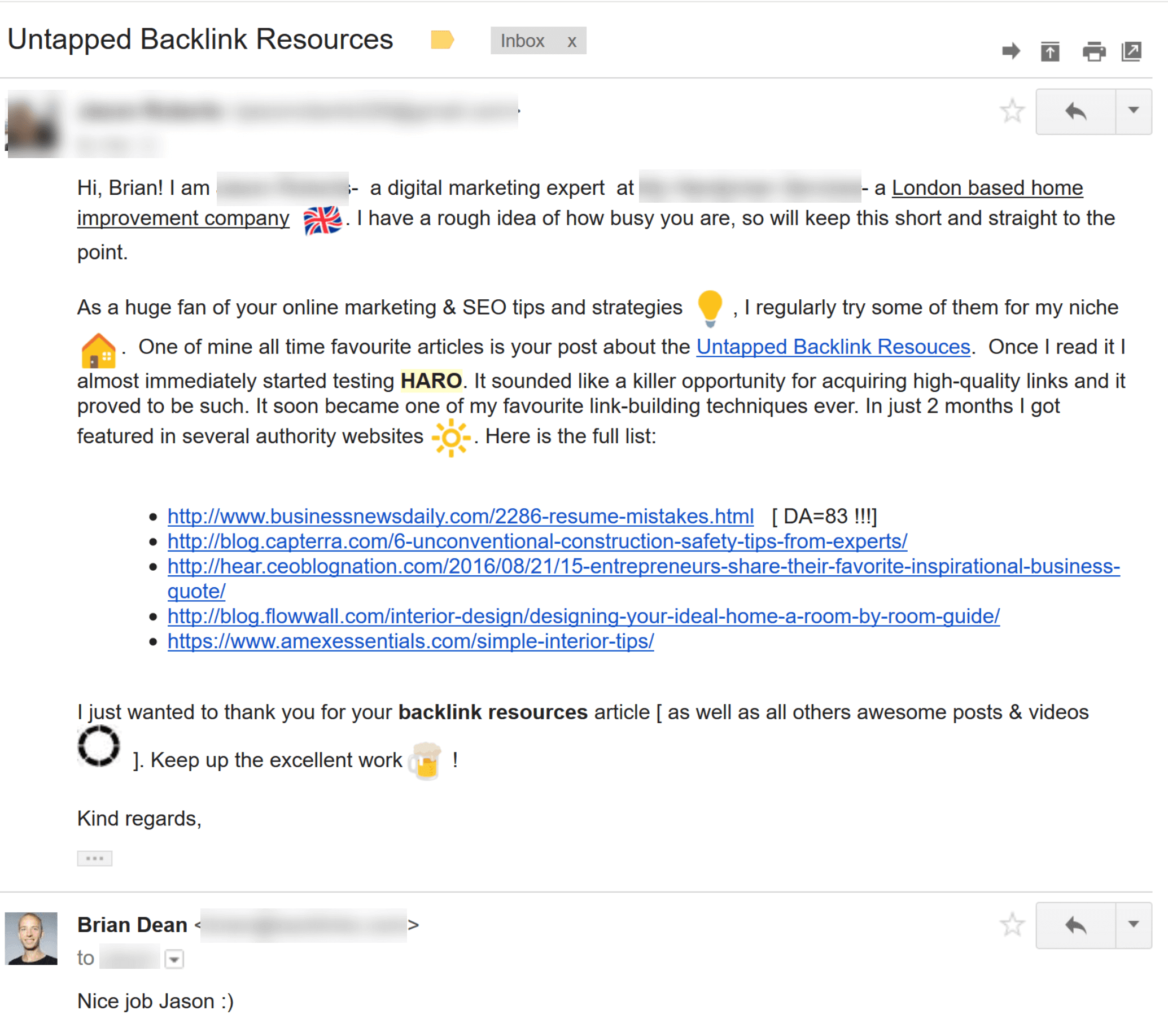

To be clear: this strategy takes work. And it’s not always easy.
But in my experience, it’s one of the best ways to build high-quality backlinks at scale.
With that, let’s dive into the step-by-step process.
First, register as a source.


Next, choose a free or paid plan.


Then, keep an eye out for requests that you can contribute to.


Finally, send the journalist a VERY brief and valuable pitch.
A while back I saw a request on a now defunct platform, HARO, from someone asking: “What’s the difference between graphic design and web design?”.
So I submitted this pitch:


And I got this sweet link from a DR76 university site.


Find all of your backlinks
Explore the largest, fastest, and freshest backlink management tool.
2. Publish “Skyscraper” Content
I’ve used “Skyscraper” content to build backlinks from authority sites like Entrepreneur.com:


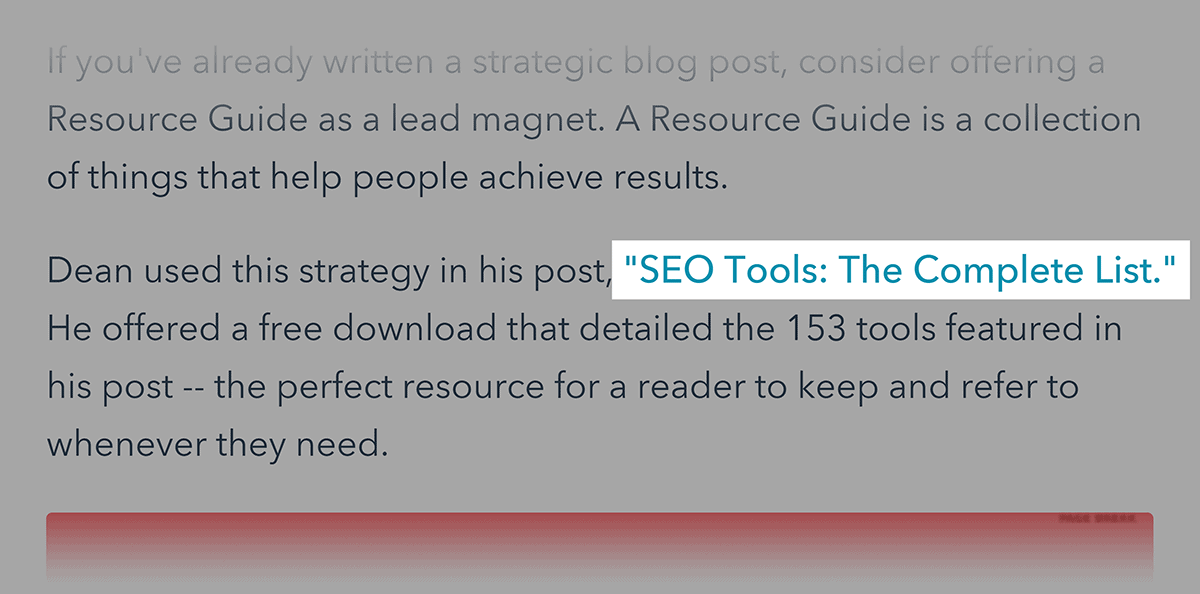

And I even got an editorial link from the GoDaddy blog:


Yup, you’ve probably noticed that they’re all linking to the same piece of content: SEO Tools: The Complete List.


Well, my list of SEO tools is a piece of “Skyscraper” content.
And that page has generated 10.2K total backlinks.


But more important than that, as you just saw, many of those links are quality backlinks from authority sites.
The question is:
How can you do the same thing?
Here’s the step-by-step process:
First, find a piece of content in your industry that’s already performed well (in terms of backlinks).
The easiest way to do that?
A simple Google search.
Just search for your keyword…
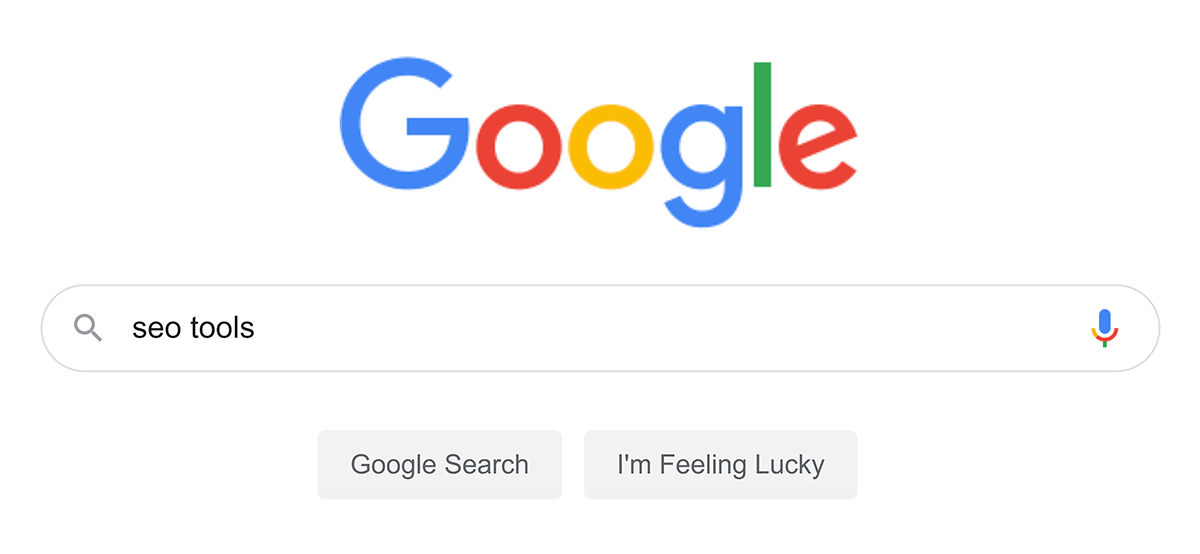

…and check out the first page results:
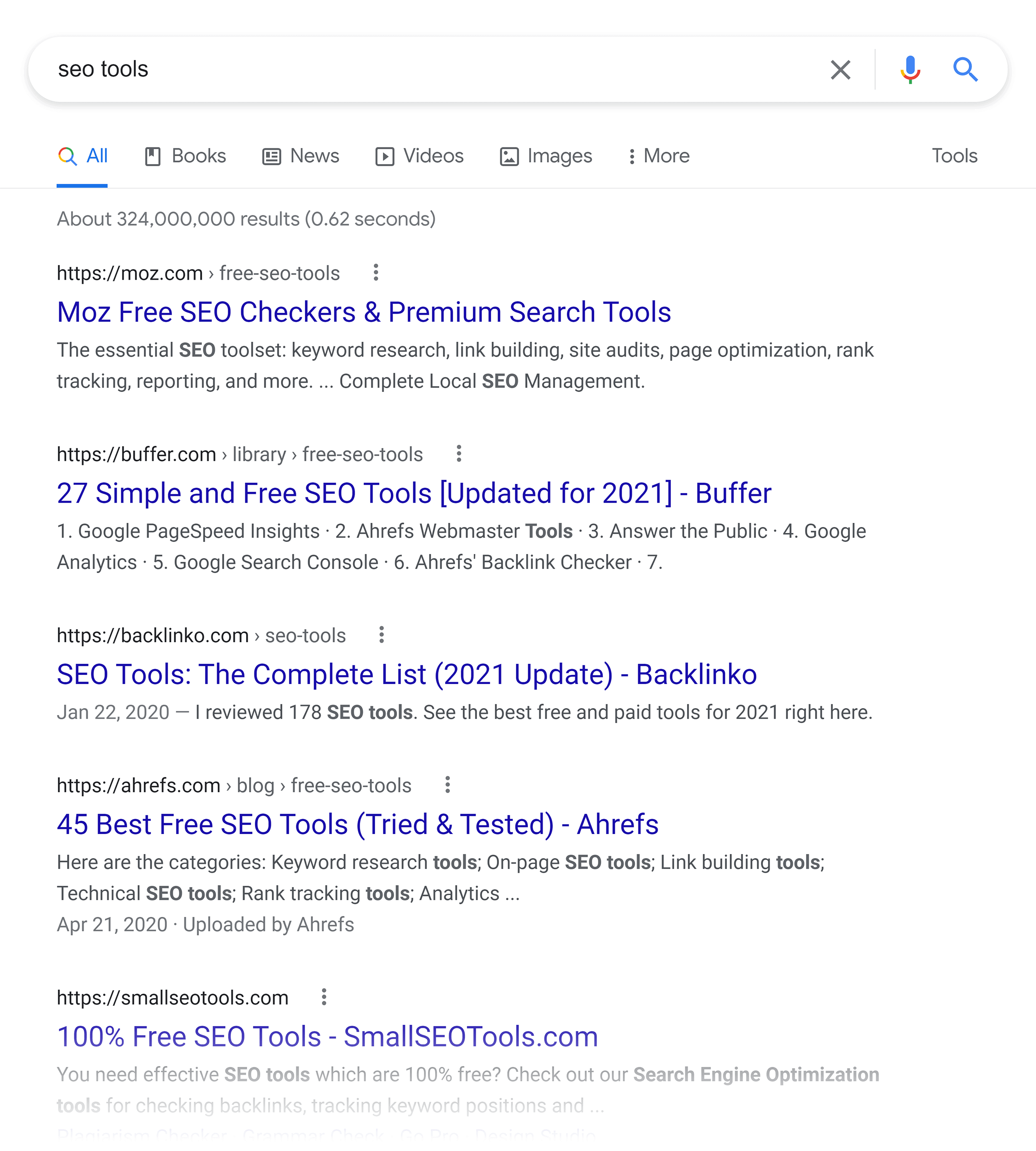

As you know, backlinks are a super important Google ranking signal.


So if a page is ranking on the first page, lots of people have probably linked to it.
Next, create a piece of content that’s 5-10x better than what you just found.
For example, I noticed that most of the SEO tools lists out there were pretty short.
So I decided to create something that was 10x better.
Unlike most other lists of SEO tools, my post contained every tool on the market (170+ tools).


Was this piece of content easy to make? Nope!
But it was worth it. To date, my SEO tools list has been shared on social media 20,777 times…
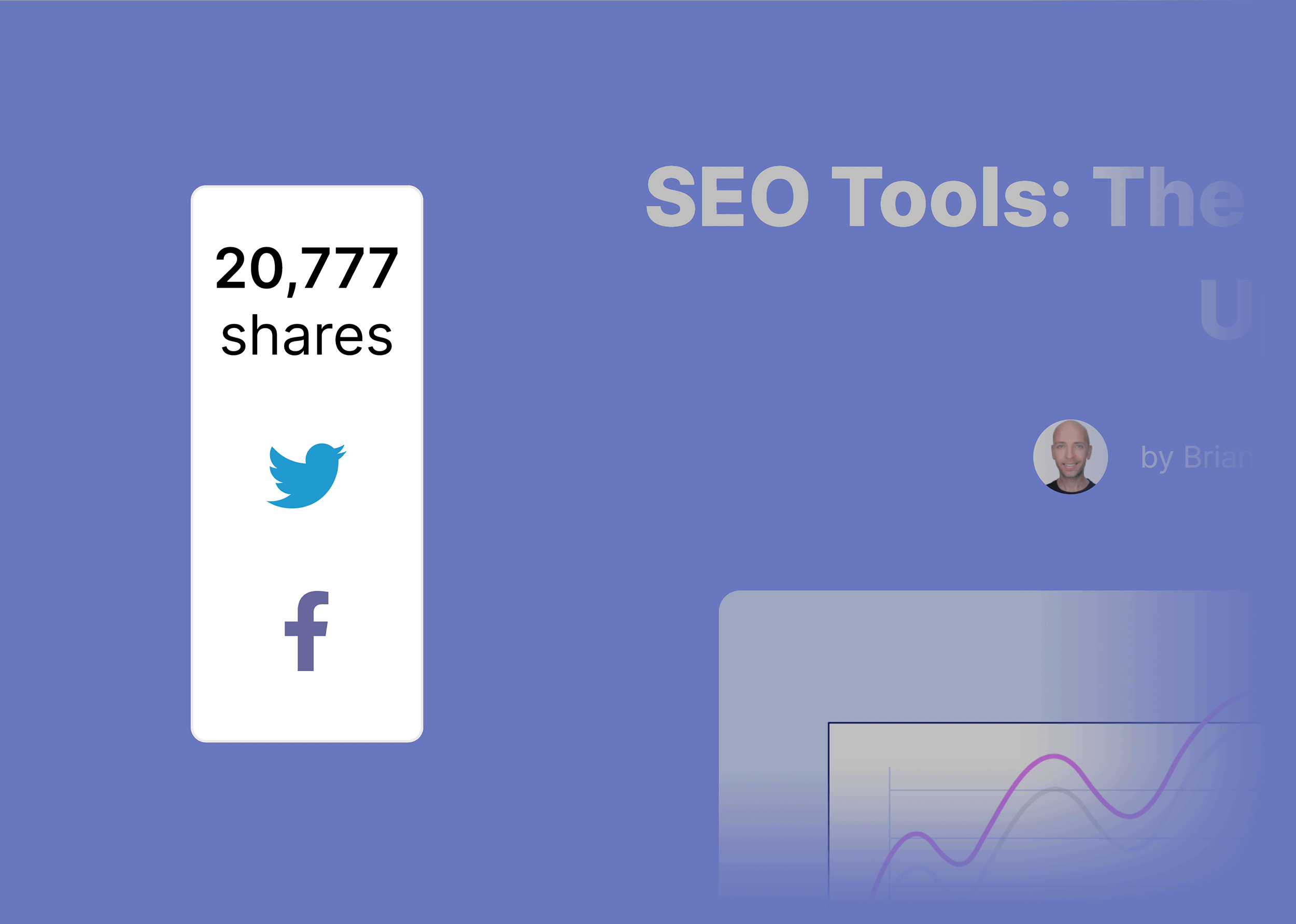

…and has backlinks from over 1.08K different domains:
Finally, promote your “Skyscraper” content.
Yes, a piece of Skyscraper content already puts you ahead of your competitors.
But to get the most out of your content, you need to actively promote it.
There are a million ways to promote your content.
So let me show you one quick strategy that works really well for Skyscraper content:
Promote to people that you mention in your post.
For example, I emailed all of the tools that I mentioned in my Skyscraper post. Here’s the exact script that I used:


And because I wasn’t pushy or spammy, most people were more than happy to share my content on social media (some of them even linked to it):
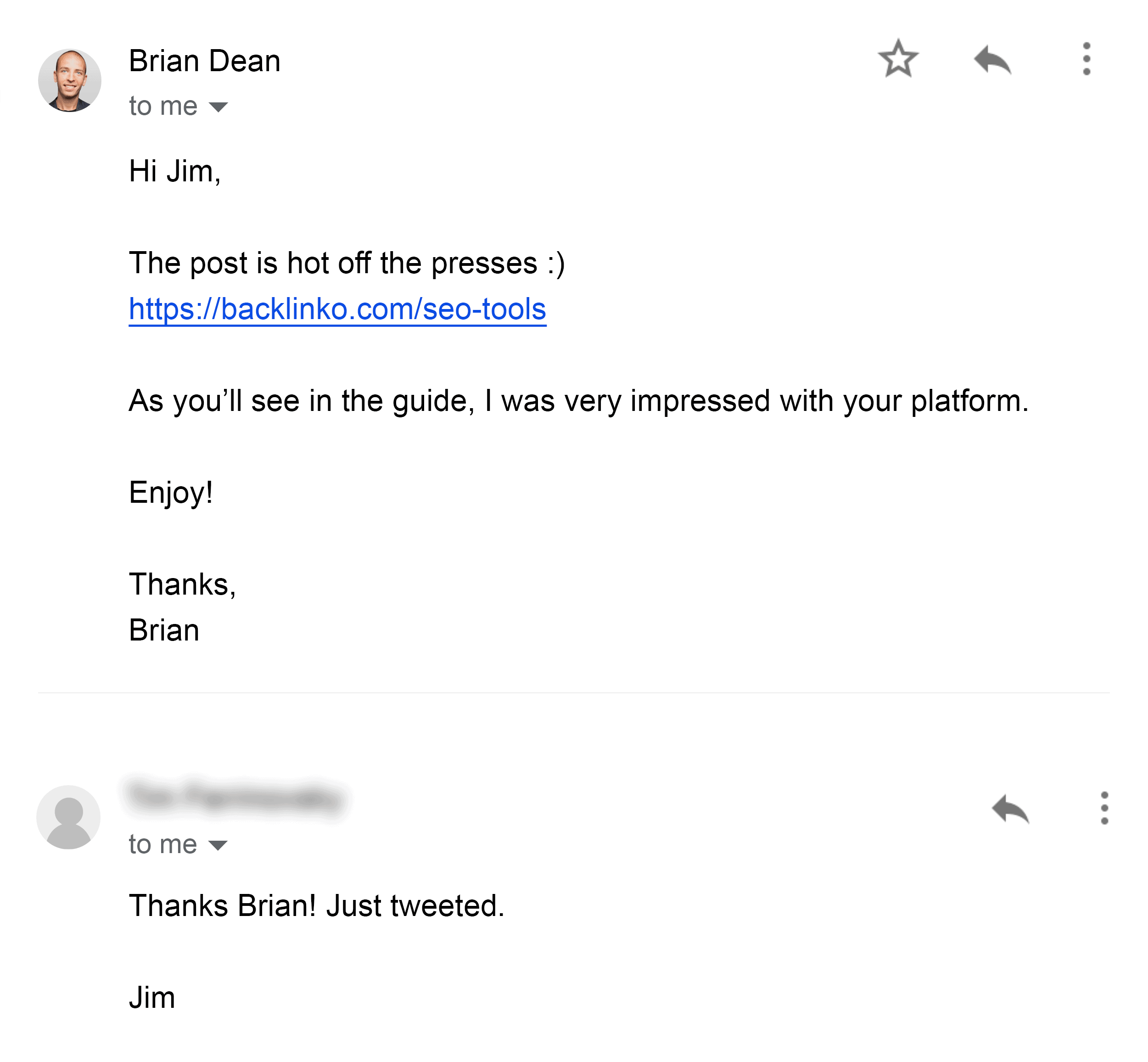

3. Build Links From Outdated Resources
Using “The Moving Man Method” I scored links from…
An authoritative .edu site:


A popular resource page:
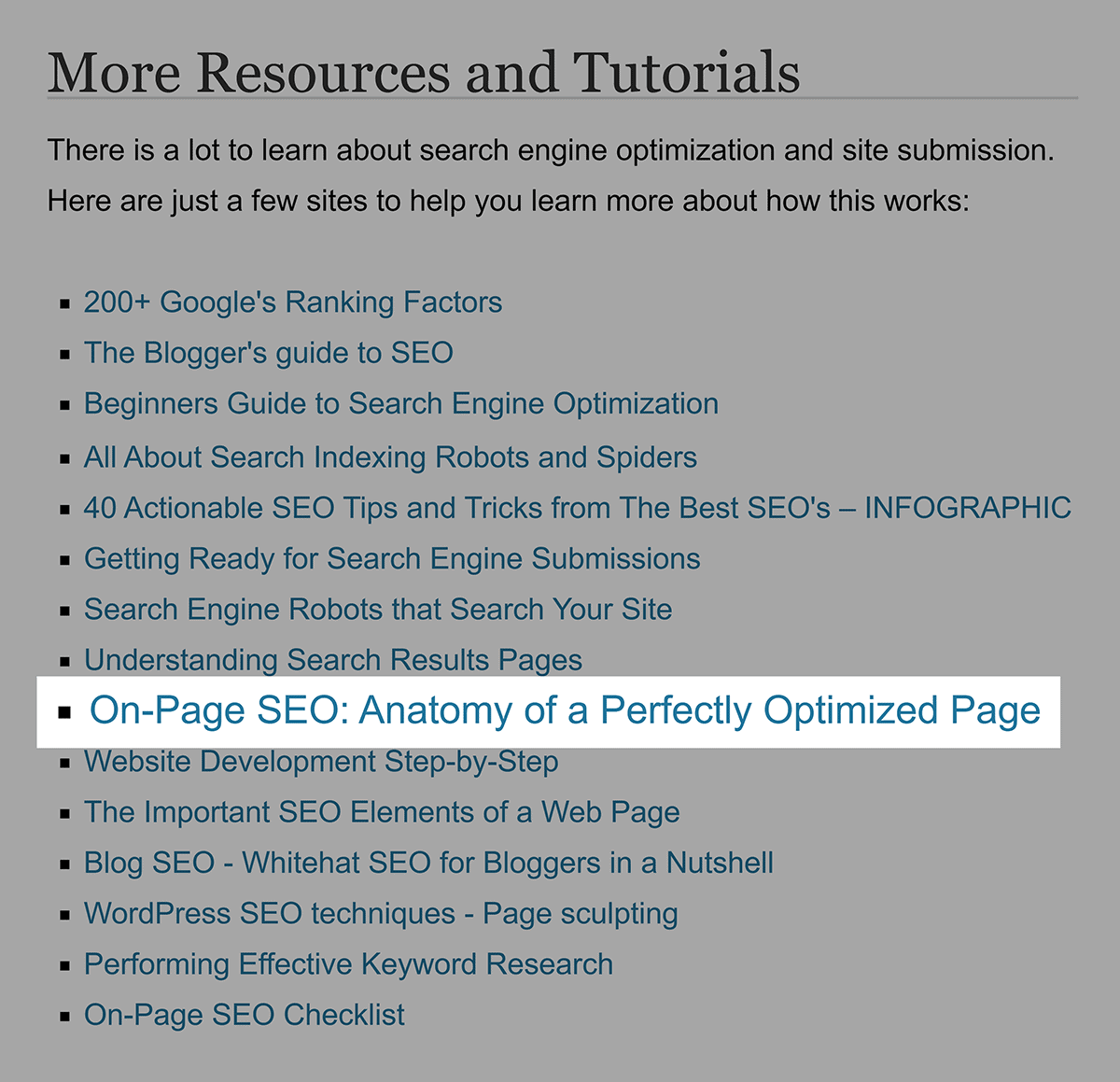

And several contextual links from relevant sites in the SEO and online marketing space, like this:




And now it’s time for the steps.
1. Your first step is to find sites in your industry that have:
- Changed names
- Moved to a new URL
- Stopped offering a service
- Stopped updating a resource
- Shut down
How about an example?
A while back SEOMoz changed its name to Moz (and moved its site from SEOmoz.org to Moz.com):
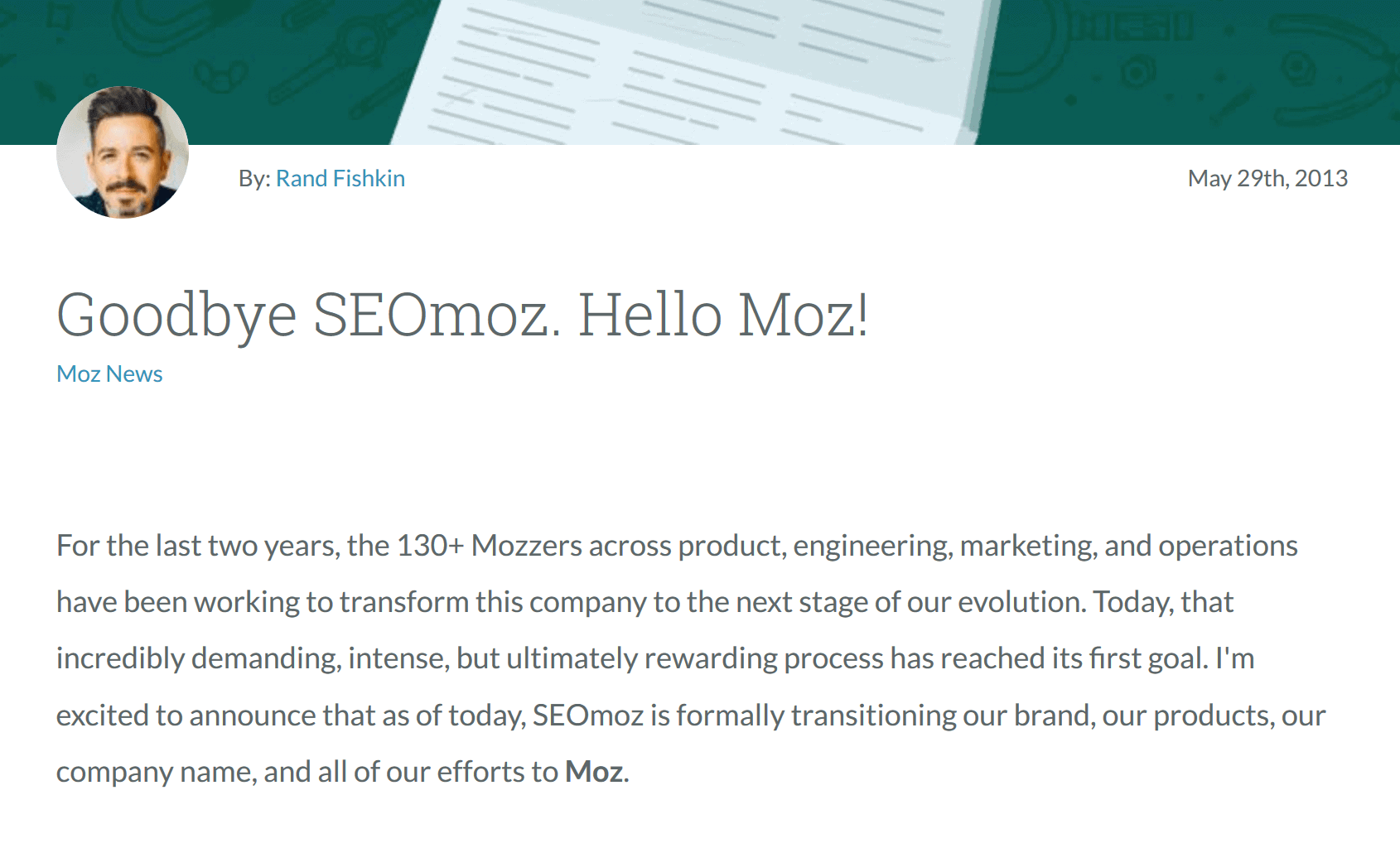

After I heard the news, I realized that this was a PERFECT opportunity to reach out to the hundreds of people still linking to the outdated SEOMoz.org URLs.
2. Our second step is to find sites still linking to the old, outdated URL
Now that you’ve found a site that was recently re-branded or a site feature that’s no longer there, it’s time to find all of the links pointing to that page.
Just grab the URL of the outdated resource and put it into your backlink checking tool of choice.


(I’m using Semrush in this example but there are lots of link building tools that you can use to do the same thing.)
Then, check out all the sites that link to the old URLs.
Depending on the site, you should have quite a few link opportunities to work with.
Either way, you want to focus on sites that have the highest Domain Authority (DA).
3. Last up, reach out and get your links.
Your last step is to reach out to all of the people that still link to the outdated resource.
You want to give them a quick heads-up about their outdated link…and gently suggest that they add your link to their site.
I tested a few different outreach email scripts for my SEOmoz/Moz campaign. Here’s the one that worked best:
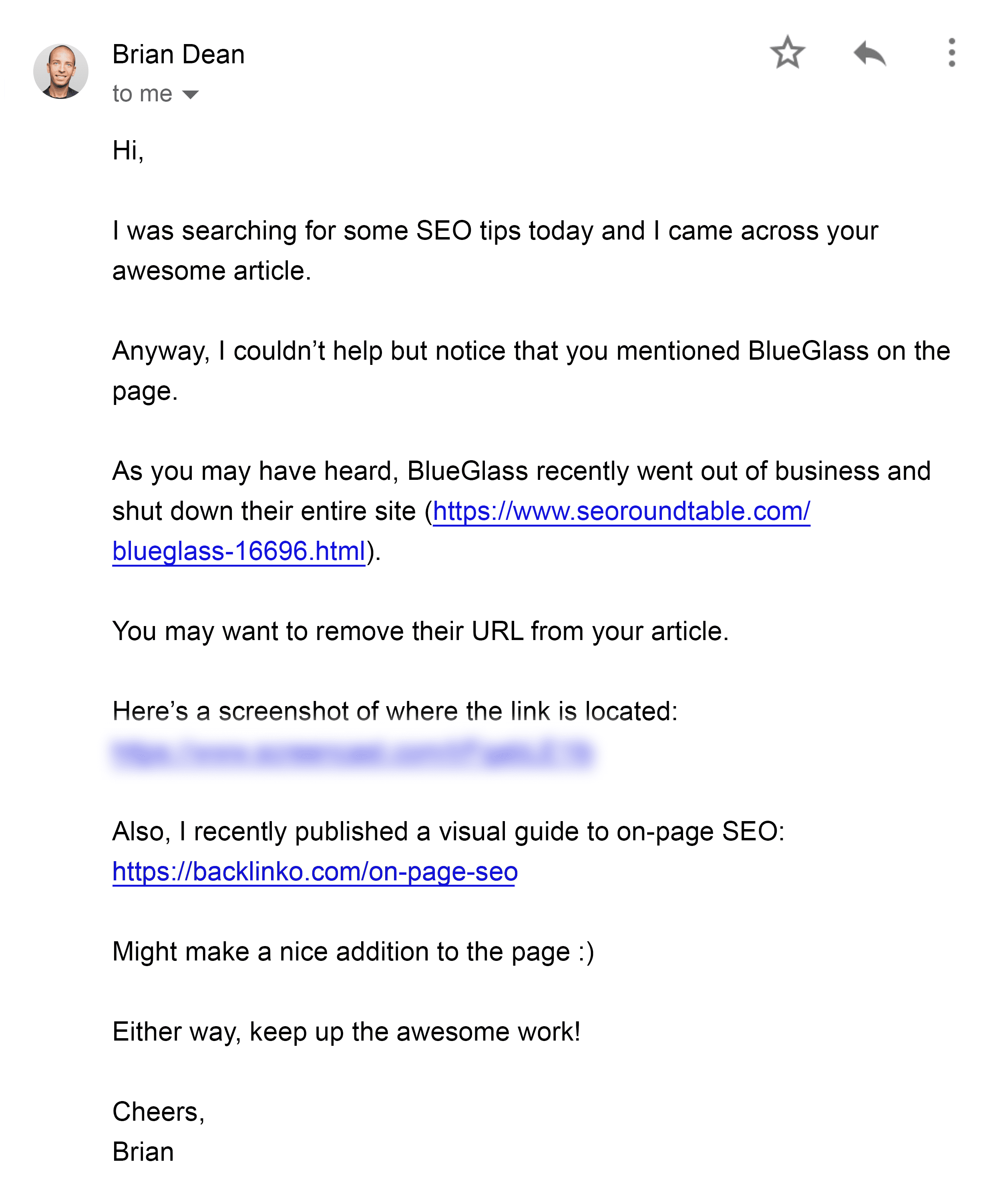

And because I added value to their site twice (once from the heads up about their outdated link and again by showing them my valuable resource) people were more than happy to add my link to their page:
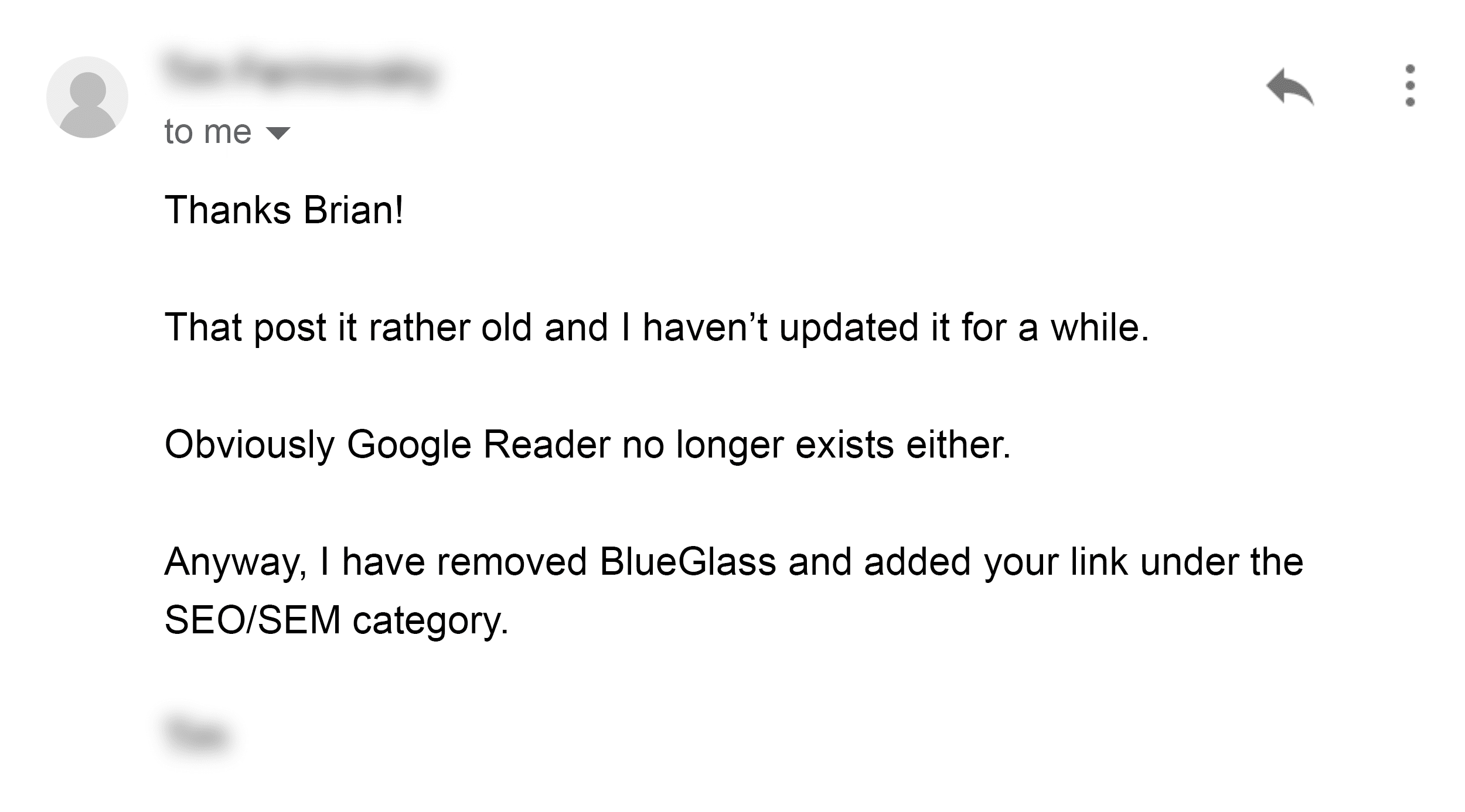

That’s all there is to it 🙂
4. Use Content Formats Proven To Generate Links
A while ago, BuzzSumo and I did a study of 912 million blog posts and articles:
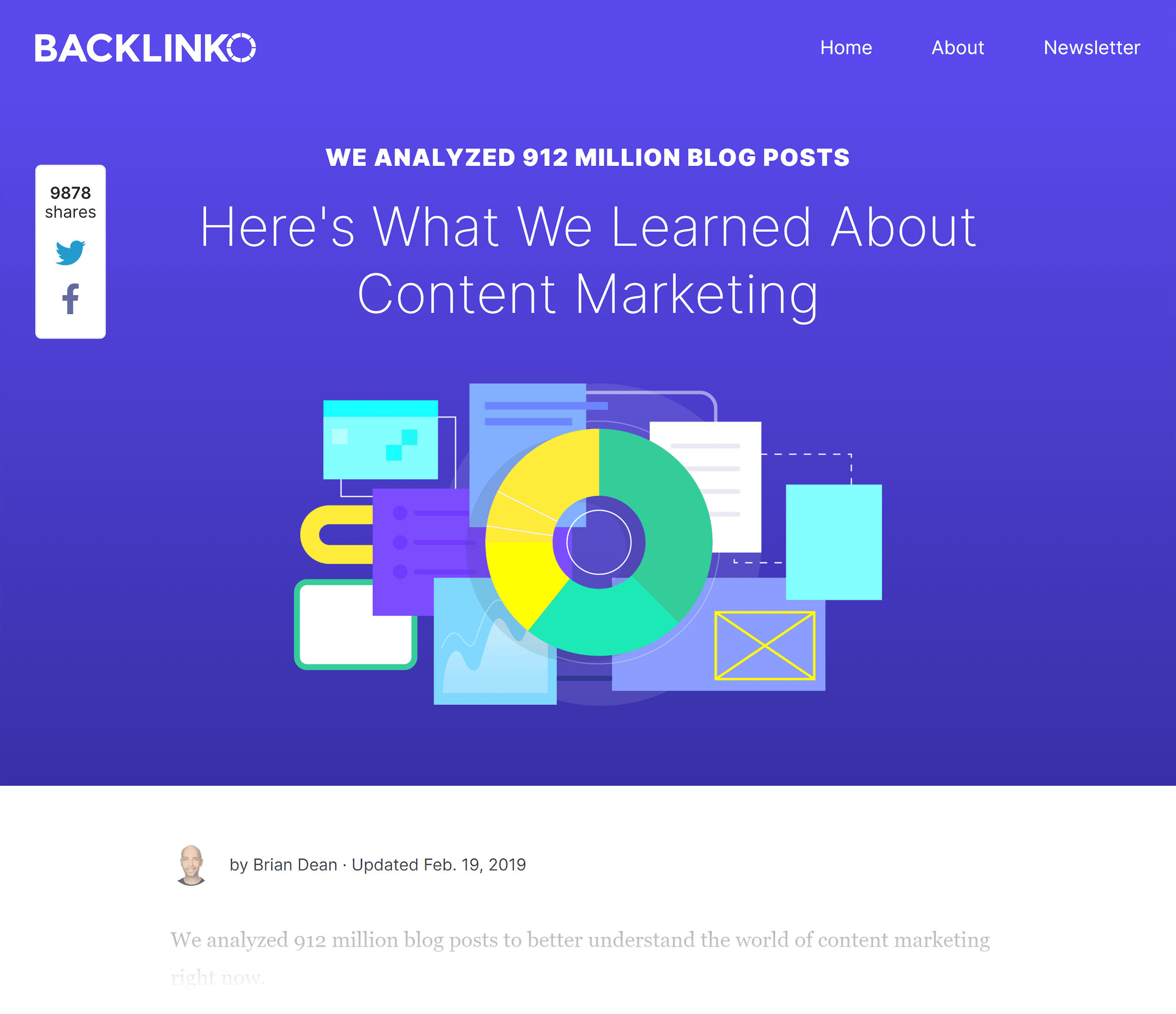

So, what did we find?
We discovered that most content is completely ignored.
In fact, they found that 94% of all online content gets ZERO links.


That’s the bad news.
The good news is, we found that certain types of content consistently performed better than others.
Specifically, we discovered that the following content formats tended to generate lots of backlinks:
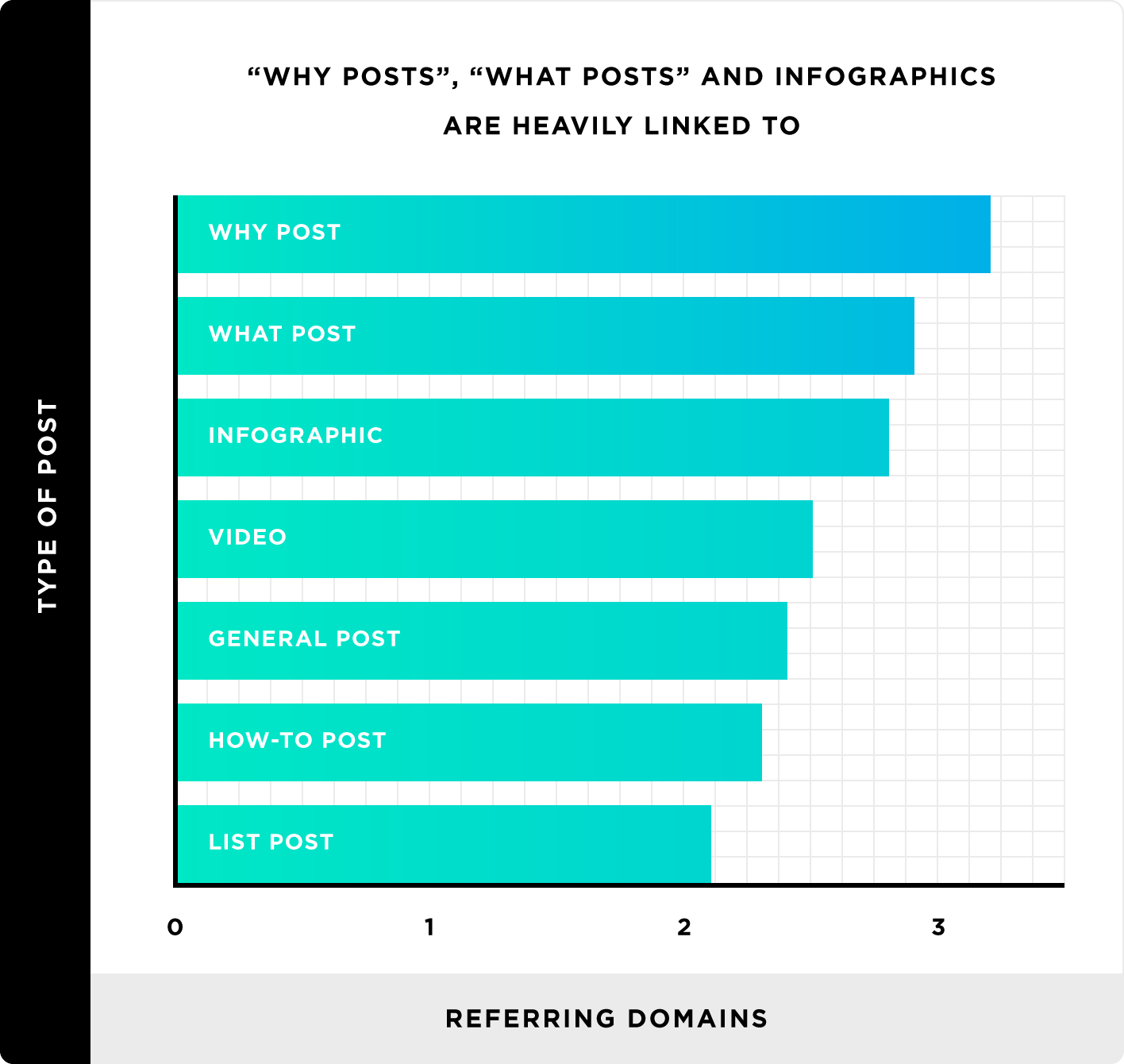

In other words, if you want to get backlinks, focus on these content formats:
- “Why” Posts
- “What” posts
- Infographics
- Videos
Am I saying: “Just publish a bunch of why posts and infographics?”
If you want to get backlinks today, your content has to be amazing.
But these formats give you a starting point for writing amazing content that actually works.
Reveal any company’s website traffic
Spy on your competitors’, prospects’, and potential partners’ website traffic.
5. Publish Ultimate Guides
You already know that the only way to move your site to the top of Google is to build high-quality backlinks (and lots of them).
That much is clear.
But HOW do you get other sites to actually link to you?
Ultimate Guides.
For example, here’s an Ultimate Guide to link building that I published a while back:
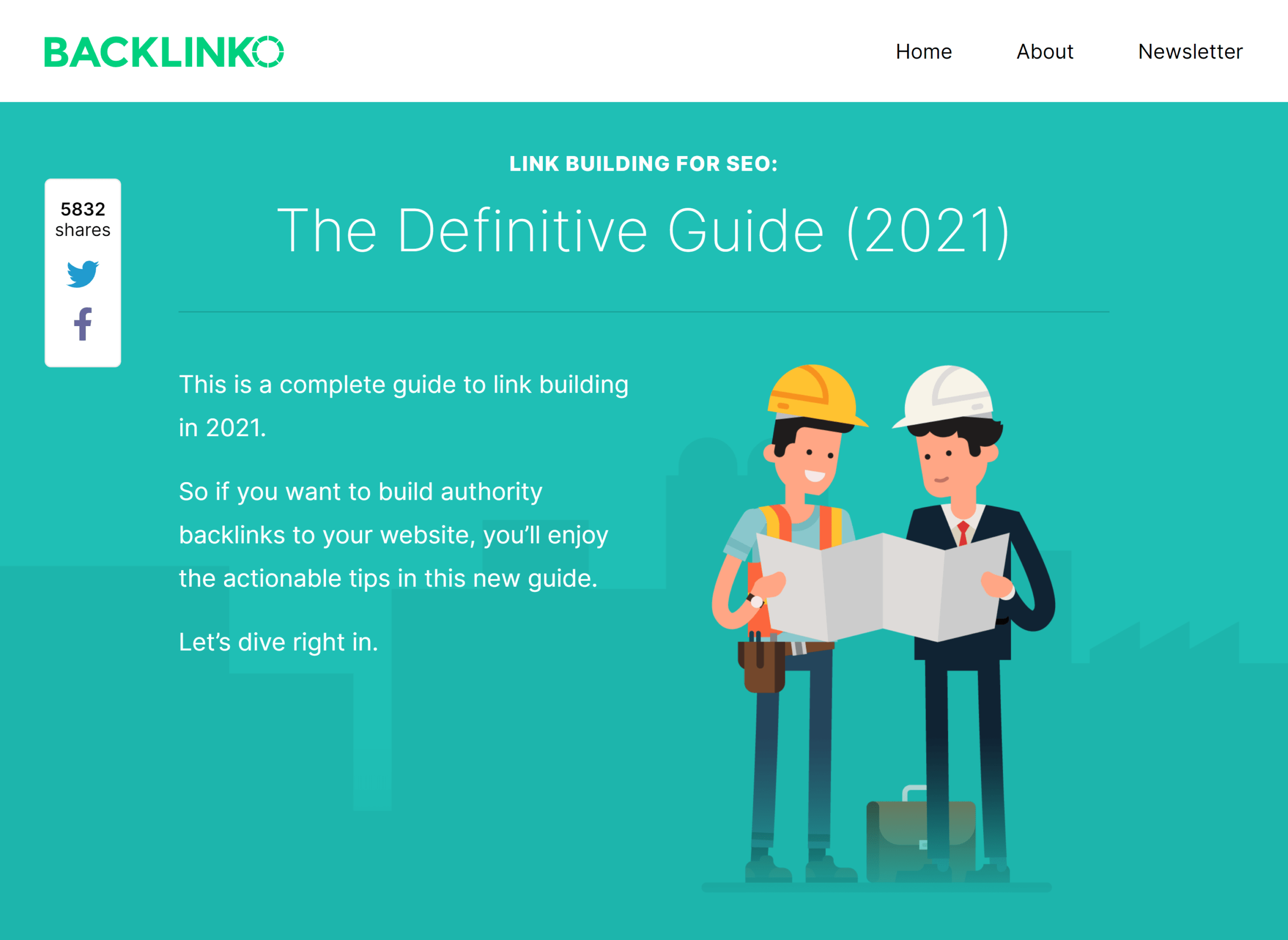

Even though I wrote that guide 6 years ago, it continues to generate links today (in 2024).


Why do Ultimate Guides work so well?
First, comprehensive guides tend to contain A LOT of content on a single page. In fact, my guide to link building is a whopping 4,834 words.
According to lots of SEO ranking factor studies (including ours), long-form content tends to perform better in Google than short articles:
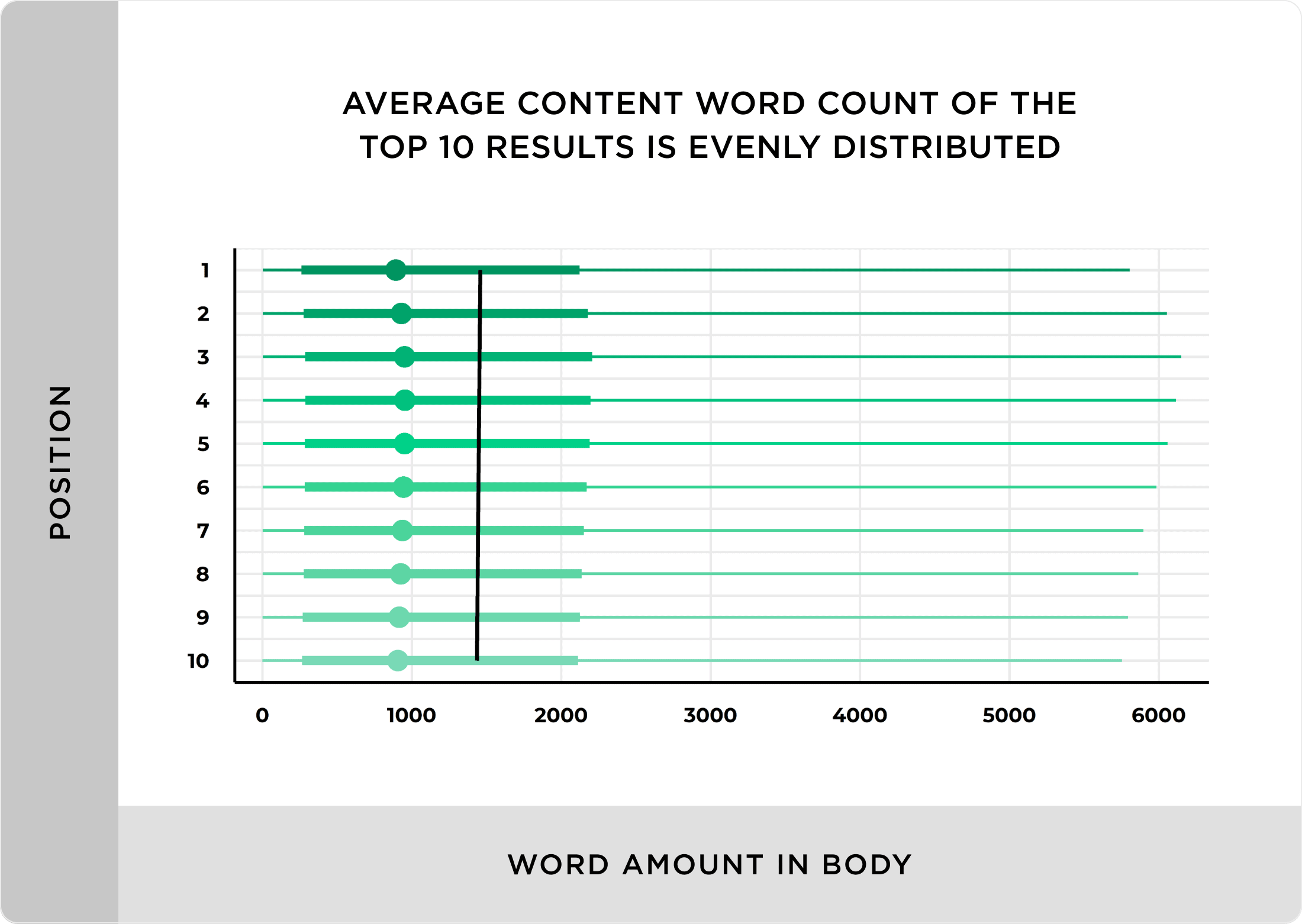

Also, ultimate guides cover an entire topic on a single page.
And because your guide is the “go-to” resource for a topic, people will link to it whenever they write about that topic on their blog:


Here’s exactly how to create an ultimate guide, step-by-step.
1. Your first step is to find a topic for your guide.
This is important.
You want to choose a popular topic that hasn’t been covered to death already.
(In other words: you don’t want to publish the 18th ultimate guide on a topic.)
For example, when I published my link building guide, I noticed the first page of Google had some helpful posts…


…but no ultimate guides.
I also considered writing an ultimate guide to SEO. But there were already a thousand guides on that topic:
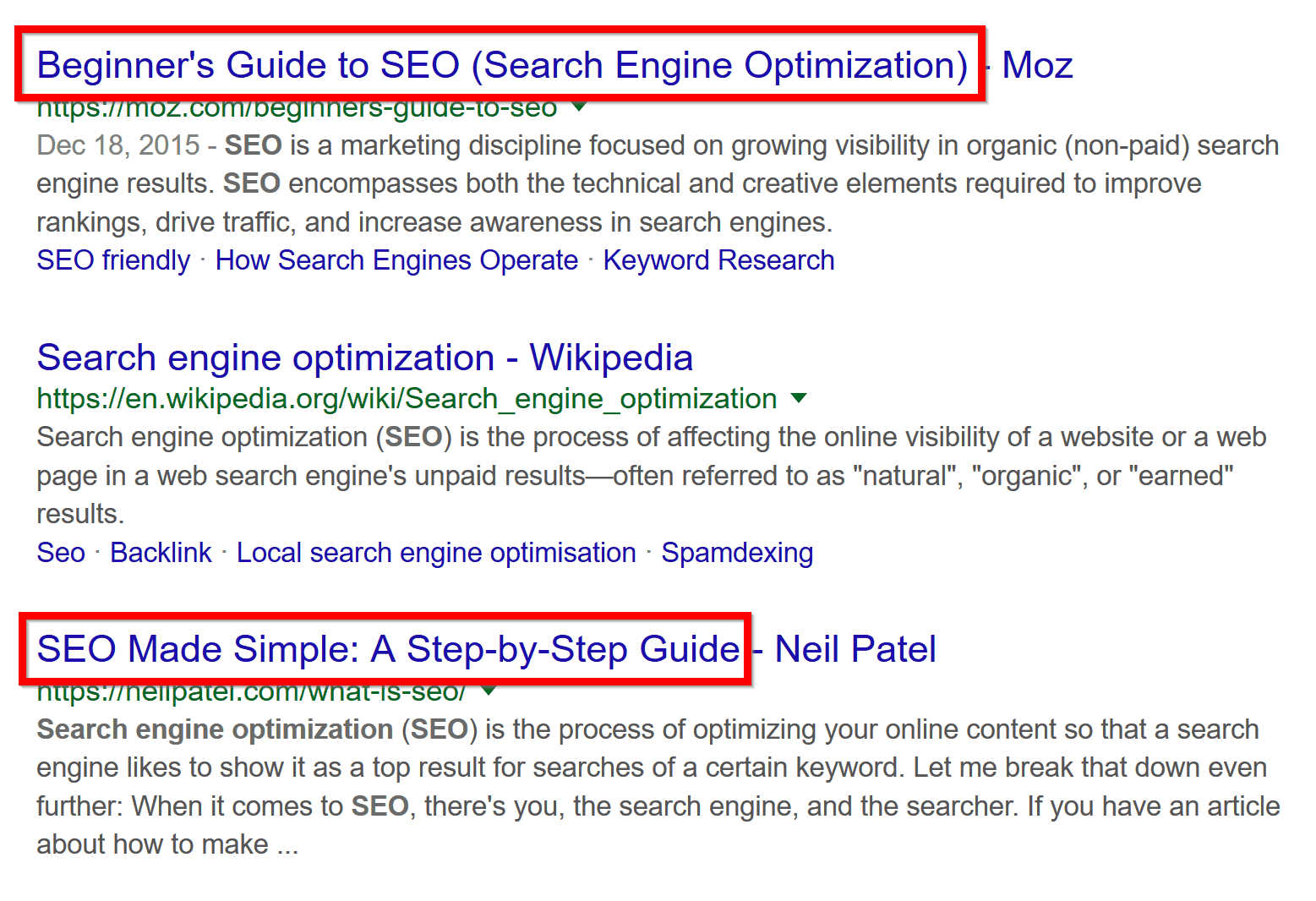

So I went with link building.
2. Next, outline your ultimate guide.
Just list out subtopics that make up your larger topic.
For example, for my link building guide, I simply listed out subtopics like this:
- What is link building?
- Black hat SEO
- White hat SEO
- Anchor text
- Content
- Email outreach
- Advanced tips
And many of these subtopics each became sections of my guide:


3. Lastly, write your Ultimate Guide.
Don’t be afraid to cover everything there is to know about a topic.
That way, your guide will be seen as the definitive resource.
(And like I mentioned earlier, longer content tends to generate more backlinks, shares… and higher rankings in Google.)
6. Use Branded Strategies and Techniques
Remember strategy #3 from this guide?
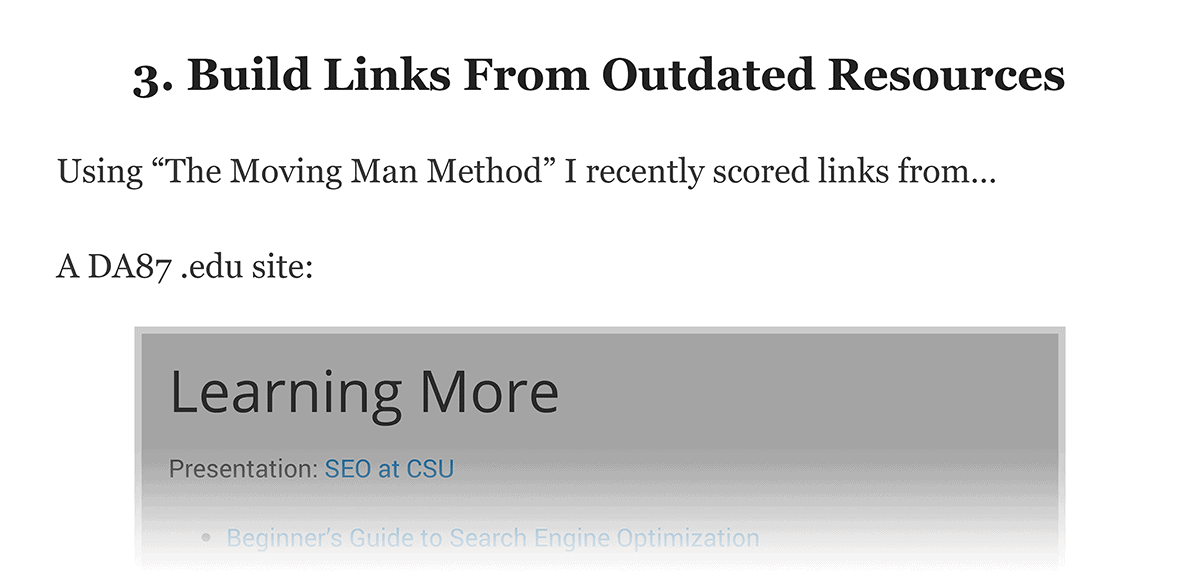

You might have noticed that I didn’t just outline the strategy… I also named it.


This wasn’t the first time that I mentioned the “Moving Man Method” in a blog post.
In fact, thanks to naming my strategy, people link to my content on The Moving Man Method fairly often:
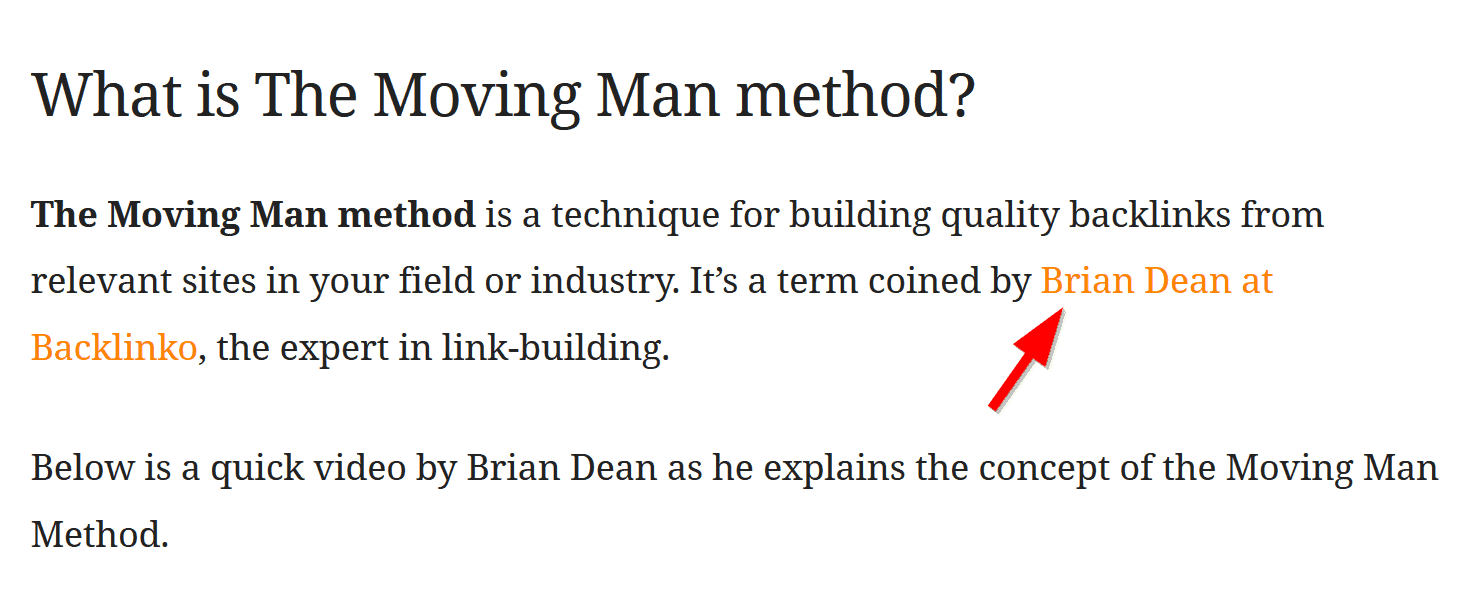

(People even publish entire blog posts about it.)


And those links only happened because I gave my strategy a memorable name.
How about another example?
Ramit Sethi created a strategy for looking like a rockstar at meetings called “The Briefcase Technique“:


And because Ramit named his strategy, he got a bunch of amazing links:
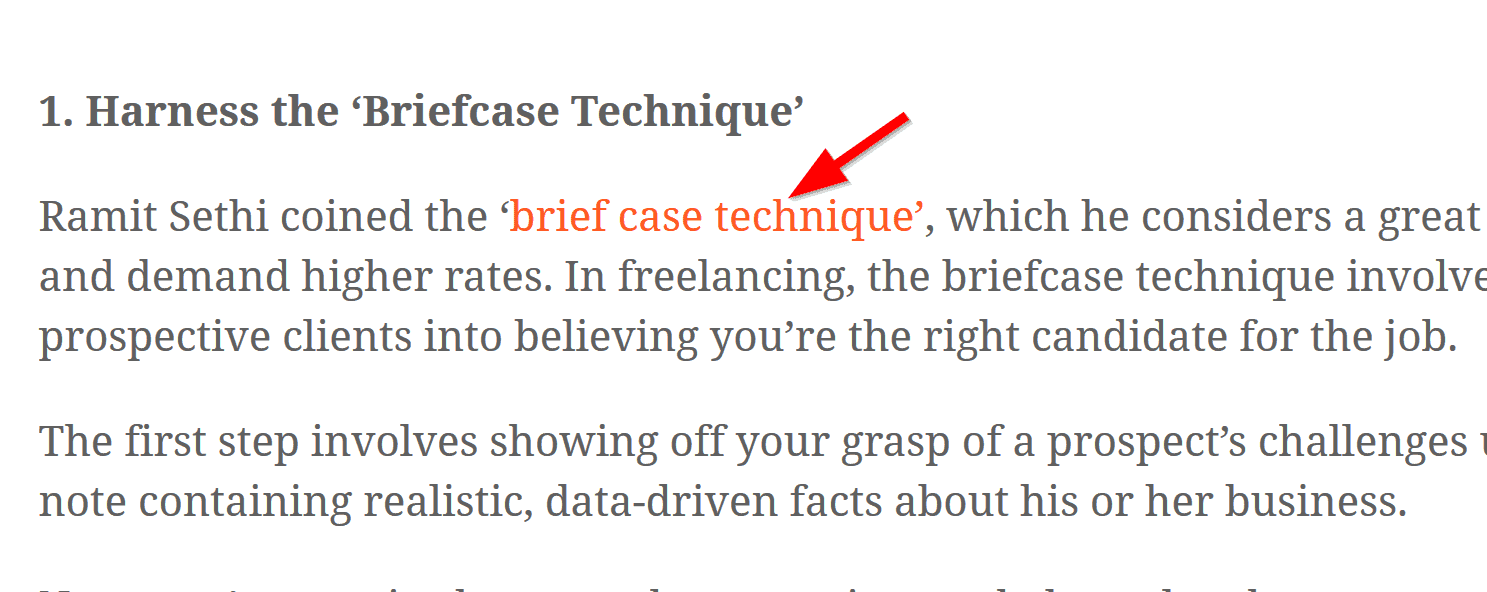

Now that you’ve seen how well this can work, it’s time to cover the specific steps:
Step #1: Develop a Unique Strategy, Tip, or Tactic
This sounds harder than it actually is.
All you need to do is come up with a strategy that has SOMETHING unique about it.
(In other words, the entire strategy doesn’t need to be unique.)



You may not have unique ingredients, but you’ve got a unique recipe.
And that unique recipe is all that matters.



For example, let’s look at The Moving Man Method.
People have been using broken link building as part of their link building campaigns for years.
So what made my strategy different?
My unique twist was that the links weren’t necessarily broken (as in, they didn’t necessarily show a 404 error).
The links I used for The Moving Man Method technically worked… they were just outdated:
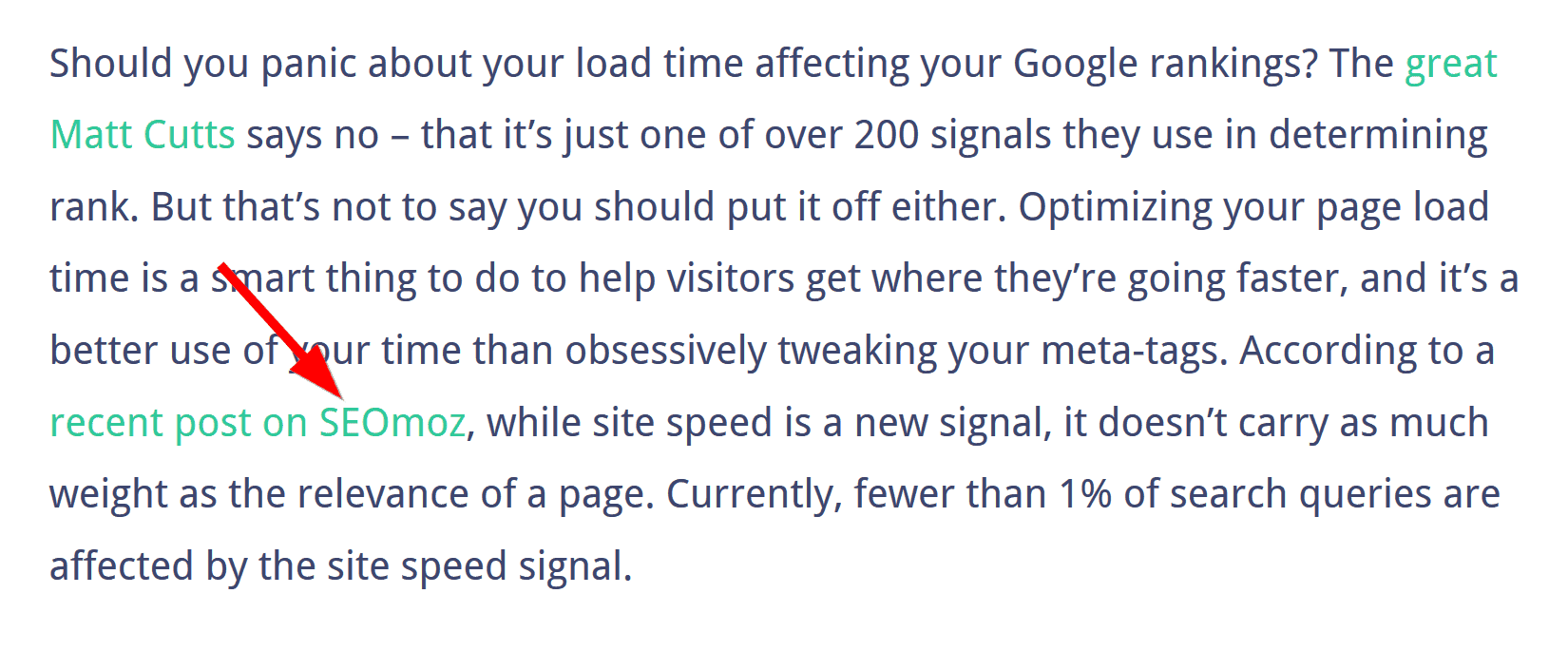

And that was unique enough.
Step #2: Next, name your strategy.
I called my strategy The Moving Man Method because you’re helping the site owner “move” their link.
Not the most creative name, but it gets the job done.
So yeah, just make sure the name describes what your strategy does.
Other than that, try to use one of these words in your strategy name:
- Method
- Technique
- Approach
- System
- Blueprint
You get the idea 🙂
Step #3: Publish the strategy as part of a blog post.
Your last step is to show people that your new strategy actually works.
Publish your strategy in the form of a blog post. Preferably a case study.
(That way, people have something to link to when they reference your technique.)
For example, here’s the post I used to announce The Moving Man Method to the world:
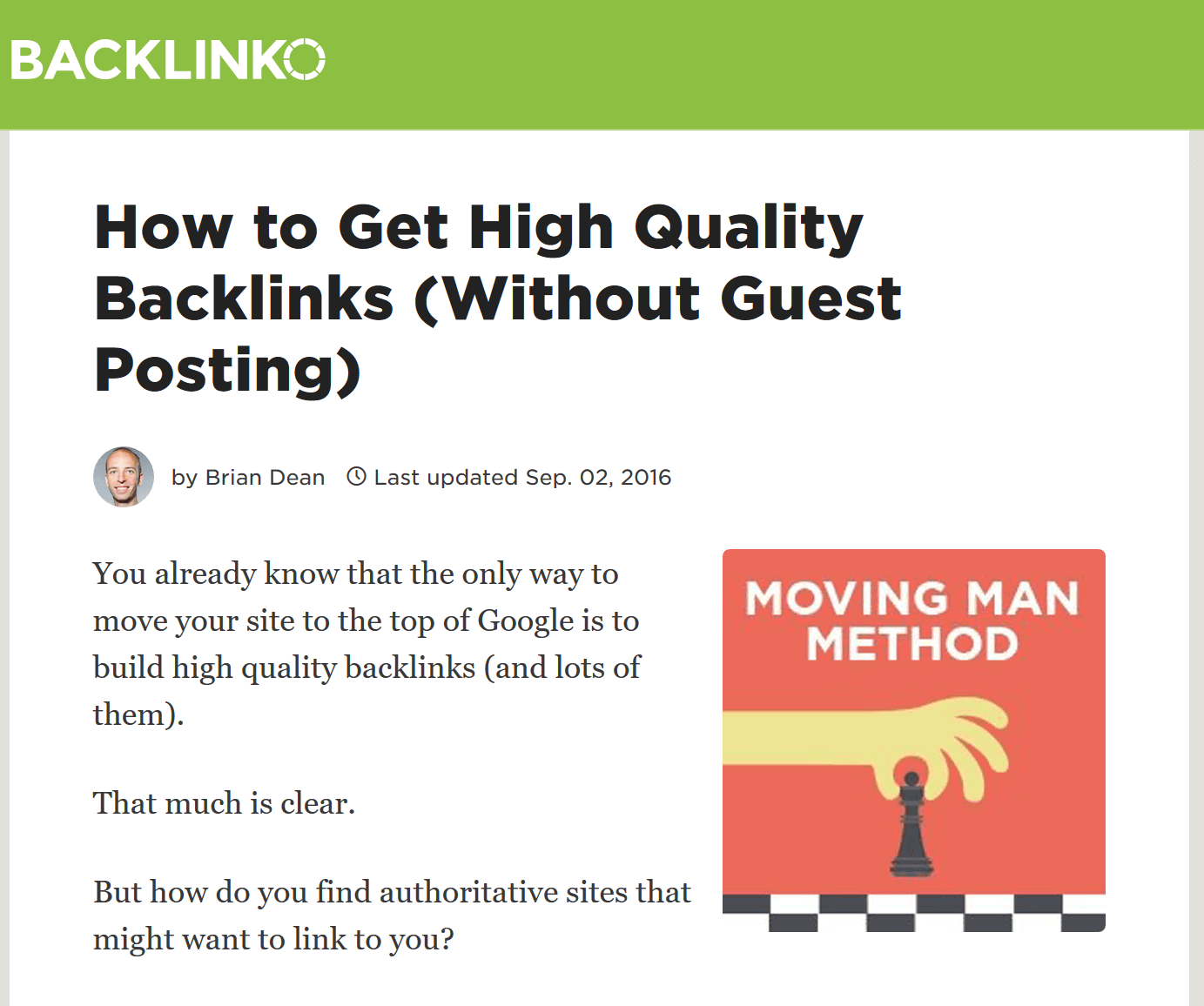

In this post, I didn’t just say: “Look at my new strategy. It probably works!”.
Instead, I showed people proof that The Moving Man Method works:


And that 1-2 punch (a branded strategy + proof) is an asset that can result in lots of backlinks.
7. Authority Resource Pages
Resource pages are a link builder’s dream.
Why? They’re pages that exist solely to link out to other sites.
Here’s an example:


And here’s an example of a link that I built from a resource page a while ago:


You might be wondering
“OK, that’s great. But how can I get links from resource pages”?
Like every strategy in this post, I’ll walk you through the step-by-step process:
First, you need to find resource pages.
These can be tricky to find. Very few people call their resource page a “resource page”.
Instead, people tend to describe their pages with terms like:
So to find these pages, you just need to search for these terms… plus a keyword.
For example, let’s say you just published an article about link building.
Actually, we’ve published a detailed guide on how to easily ace backlink audits to help attract and build authority resource pages.
You’d do a Google search using this keyword:
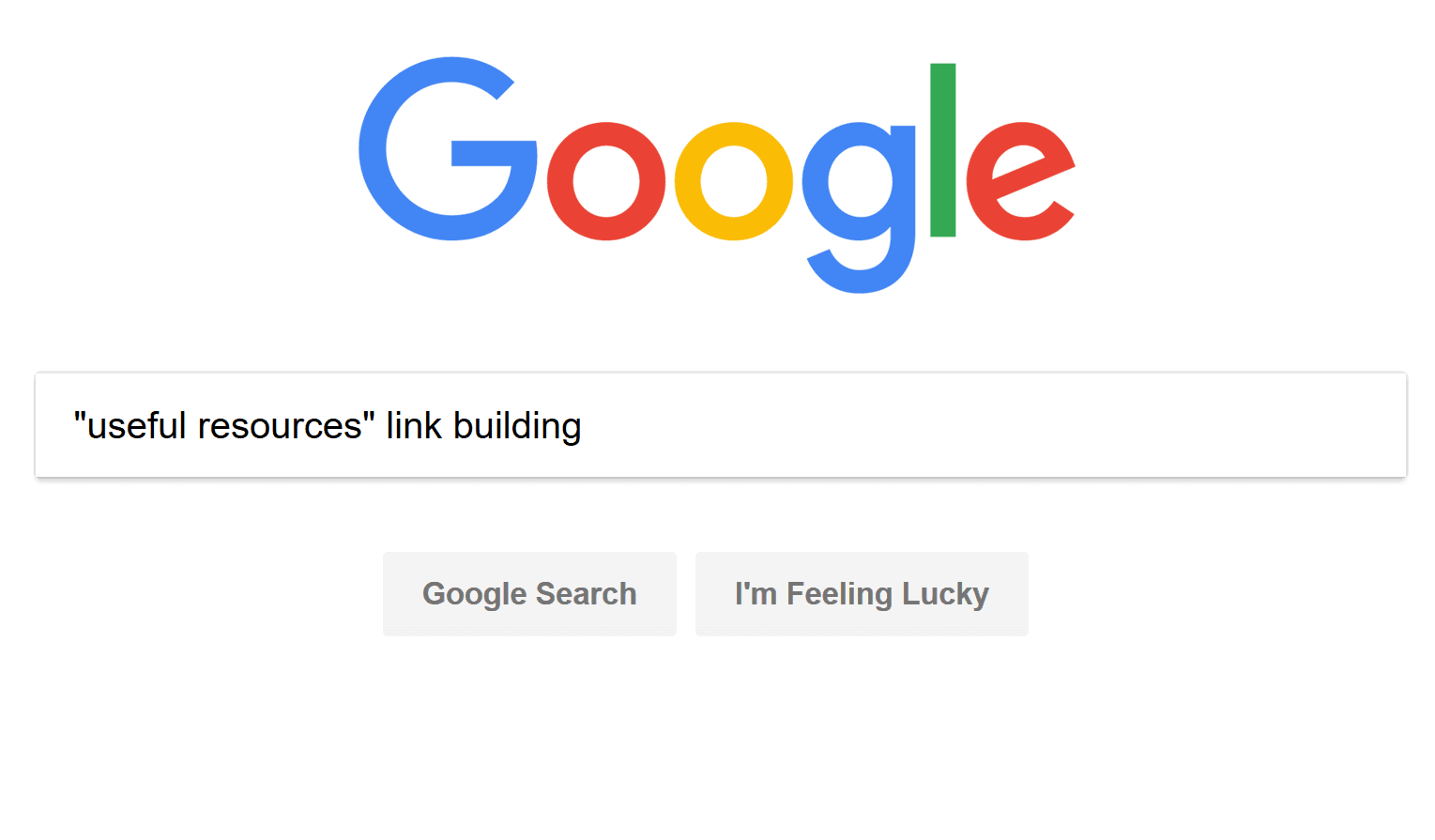

And within 5 seconds I found this massive list of link building resources:
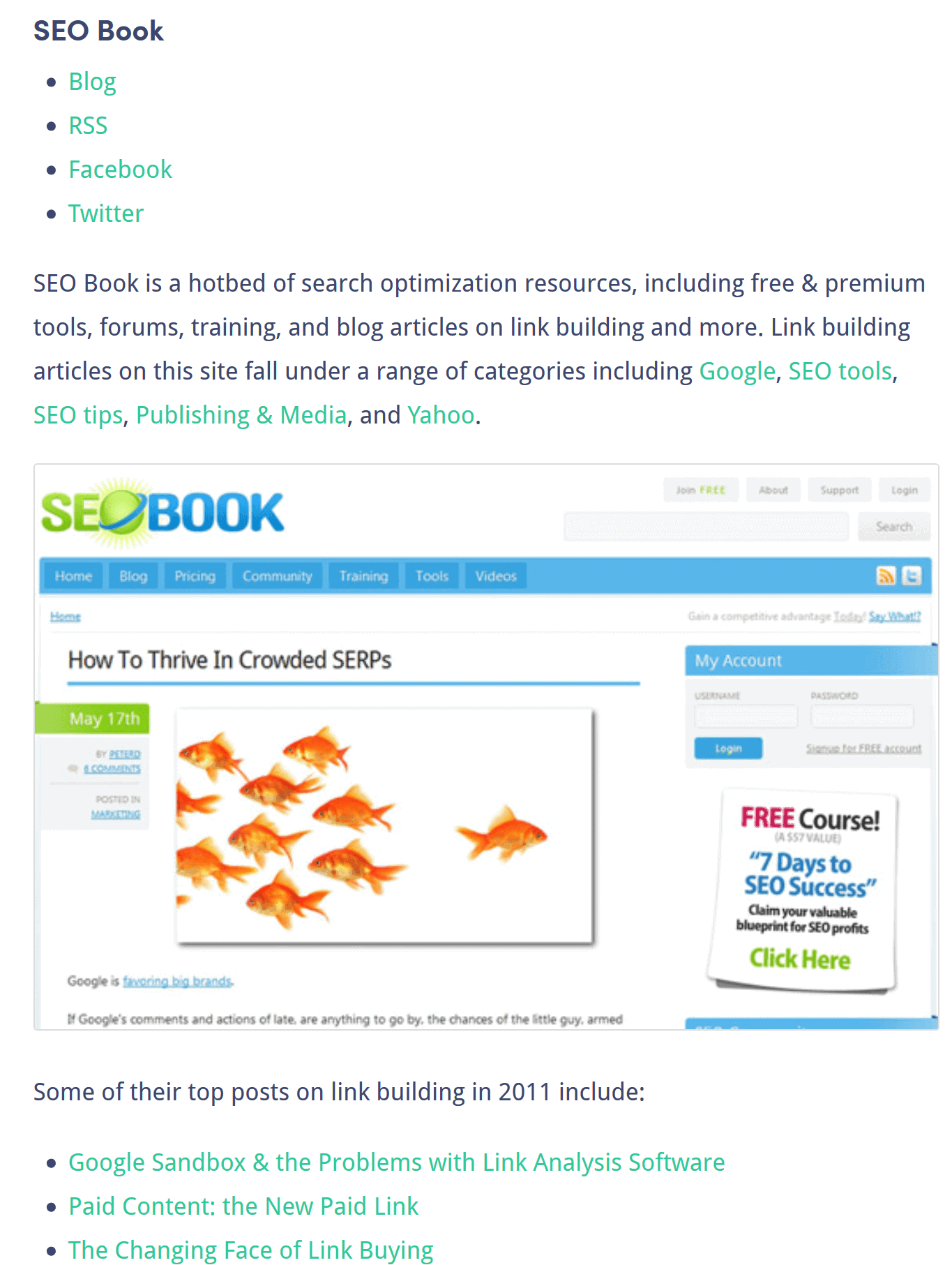

Second, now that you’ve found a resource page, it’s time to reach out and (nicely) ask for a link.
Here’s the email script that I recommend:
I was looking for some articles to read about [You Topic] today, when I stumbled on your [Resource Page Title] .
Anyway, I noticed that you have a section on your resource page dedicated to [Your Topic] . I actually recently published a massive guide on that same topic. It might be worth adding to your page.
Thanks and have a great day!
Regards,
[Your First Name]
This script is just a starting point.
The more you personalize your outreach emails, the more links you’ll get.
But his proven script is a proven outline that you can start with.
Bonus Strategy #1: Turn Brand Mentions Into Quality Backlinks
Every once and a while someone will mention you in a blog post ..but won’t actually link to your site.
Here’s an example:


See how that person mentioned my site… but didn’t link to me?
That’s called an “Unlinked Brand Mention”.
These mentions are relatively easy to get backlinks from.
The author of the post already mentioned you. Which means they like you.
So you just need to send them this friendly email:
I just came across your latest article: [Article Title] .
I just wanted to reach out and say “Thanks” for mentioning [Your Brand Name] in your article. I really appreciate that.
Also, if you have a minute, it would be great if you could link to our site. That way, your readers can easily find the post on our blog that you mentioned.
Again, thank you for mentioning us in your article. And have a great day.
Best,
[Your First Name]
Bonus Strategy #2: Send “Feeler” Emails
When it comes to email outreach, you have two options:
Option #1: Ask people for links in your first email
Option #2: Use a “feeler” email
From running hundreds of link building campaigns, I’ve found that both approaches can work.
But I’ve also found that so-called “Feeler” emails increase conversions by 40%+.
So: what are “Feeler” emails?
Feeler emails are messages you send to prospects without asking for a link.
(You’re “feeling out” whether or not they’re receptive to your outreach… before you make a link pitch.)
Here’s a real-life example:


See how Mike doesn’t ask for a link? Instead, he asks the person if they’d like to see it first.
IF they say “yes”, you send them your pitch:


In Mike’s case, the “Feeler” email got 40% more responses vs. asking for a link in the first email.


